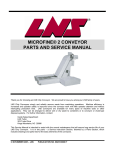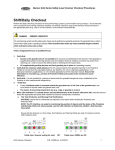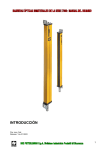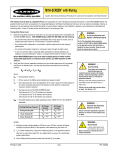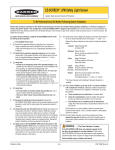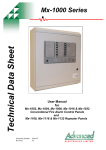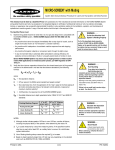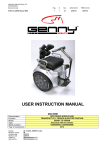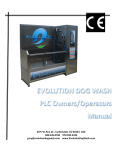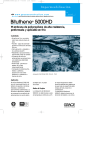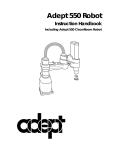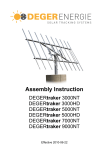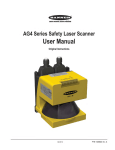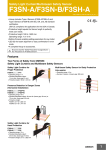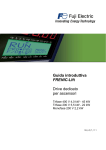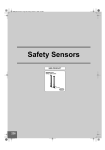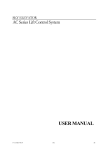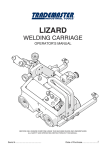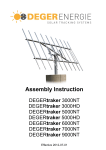Download 5000HD SERIES LIGHT CURTAINS
Transcript
5000HD SERIES LIGHT CURTAINS 1. SCOPE This manual applies to all Smartscan 5000HD Series light curtains supplied to R.S. Components. Information for use is provided for the light curtains used alone and in combination with certain accessories. When accessories are used, this manual should be read in conjunction with the user information provided with the accessory. Not all sections of this manual will apply to an individual light curtain. Where a section applies to certain models only, this information is clearly given at the beginning of the section. 5000HD Series light curtains are a Safety Product, classified as electro-sensitive protective equipment and included within Annex IV of the European Machinery Directive. Date 18 Aug 1997 Ref: 017-068D.doc Section 1.1 5000HD SERIES LIGHT CURTAINS 2. INTRODUCTION 5000HD - a range of light curtains to protect persons from coming into contact with dangerous parts of machinery. They are often used in place of conventional fixed guards or interlocked gates. The light curtains can be mounted at any angle and used as trip devices to detect the approach of persons towards the dangerous parts,, or as presence sensing devices, which detect the presence of persons in a defined area and which prevent the dangerous parts of machinery from moving while anyone is in that area. 5000HD T and L geometry light curtains are for mounting across conveyors on which products pass into or out of a hazardous area. Additional sensors within the light curtain are positioned to detect product, effectively inhibiting operation of the light curtain during the periods when products are passing through the intangible barrier, but would stop the machine should a person attempt to pass through the light curtain. Main features: * decrease in manual operating times compared with other forms of guarding, often resulting in an increase in production throughput. * unobstructed view of the safeguarded area, * manual operation of the guarding system is unnecessary thereby reducing operator fatigue, * self-monitoring fail safe design, * all models meet the Essential Health and Safety Requirements (EHSR’s) of the Machinery Directive. * high reliability * all models supported by EC Declaration of Conformity * selectable input / output configurations to suit specific machinery control applications, * effective scanning range to 15 metres, * simple installation and set-up. Date 18 Aug 1997 Ref: 017-068D.doc Section 2.1 5000HD SERIES LIGHT CURTAINS 4. MODEL LIST Conventional Straight Types Table 1 RS Part Code No of Beams Beam Pitch mm Detection Zone mm Detection Capability mm Maximum Range m Extrusion Length mm 262 3267 262 3273 262 3289 262 3295 8 16 3 16 38 38 437 76 279.4 583.4 887.4 1153.4 51.4 51.4 450.4 89.4 15 15 15 15 306 612 915 1220 Self Muting Light Curtains Table 2 RS Part Code No of Beams Beam Pitch mm Detection Zone mm Detection Capability mm Maximum Range m Extrusion Length mm 262 3302 262 3318 3 3 427 427 867.4 867.4 440.4 440.4 2.2 2.2 915 915 Date 18 Aug 1997 Ref: 017-068D.doc Section 4.1 5000HD SERIES LIGHT CURTAINS Cables Cable - Transmitter to Control Unit and Receiver and Control Unit - two required per light curtain (can be different lengths). Cables should bne chosen to have the required physical length based on the mounting positions of the transmitter, receiver and control units and the wiring routes. Table 3 RS Part Code Length m 262 3324 262 3330 262 3346 262 3352 262 3368 262 3380 262 3396 262 3403 262 3419 2 4 6 8 10 14 16 20 30 Figure 3 - Cable Layouts Date 18 Aug 1997 Ref: 017-068D.doc Section 4.2 5000HD SERIES LIGHT CURTAINS Each 5000HD system comprises: * sensing unit - the light-curtain, * control / monitoring unit, * output signal switching devices, * secondary switching device, * power supply, * mute function. SENSING UNIT (SU): The parts which detect the presence of a specified object within a defined area. These parts are within the transmitter and receiver units. CONTROL/MONITORING FUNCTION: The function that controls and monitors the sensing unit, receives and processes information from the sensing unit and provides outputs to the output signal switching devices and secondary switching device. OUTPUT SIGNAL SWITCHING DEVICES (OSSDs): The components of the Smartscan system which, when the sensing unit or safety control / monitoring means are actuated, respond by interrupting the circuit connecting it to the machine primary control element. SECONDARY SWITCHING DEVICE (SSD): The component of the Smartscan system which when in a lock-out condition interrupts the circuit connecting it to the machine secondary control element. POWER SUPPLY: Normally 24V DC, however, a 110/230V AC power supply can be supplied if required - see R.S. Part No. 442-268. MUTE FUNCTION: A function for automatically switching the light curtain into a condition where the output signal switching devices (OSSDs) do not respond to actuation of the sensing unit. The mute control / monitoring function also monitors the status of the mute initiating signals. Some models incorporate self-muting. Refer to Sections 4 and 7 for further details of the models available. Date 18 Aug 1997 Ref: 017-068D.doc Section 2.2 5000HD SERIES LIGHT CURTAINS FIG. 1 - EXAMPLE LIGHT CURTAINS Two columns house the transmitting and receiving equipment. Internal power supplies, control / monitoring , output signal switching devices and secondary switching device are within the control unit. Status indicators and diagnostic LEDs are provided to aid set-up and simplify alignment and maintenance of the equipment. Two plug-in interconnection cables are supplied, one for linking the transmitter and control unit and the other for linking the receiver and control unit. The transmitter and receiver columns are positioned to face across the area to be safeguarded. The transmitter column contains a row of light emitting diodes which transmit beams of infra red energy to corresponding receptor diodes in the receiver column. Interruption of any of the beams within the light curtain will switch the output signal switching devices (OSSDs) to an OFF-state, which will in turn stop, or prevent start-up of an associated machine. User connections (power supply, outputs and control signals) are made to terminals within the control unit. Date 18 Aug 1997 Ref: 017-068D.doc Section 2.3 5000HD SERIES LIGHT CURTAINS The 5000HD system provides a high level of safety integrity which ensures that failure of all, or part of the equipment, interruption of the power supply, or spurious external effects do not reduce the level of protection. The 5000HD system provides two basic modes of operation: Latched mode: When power is applied the outputs stay in the OFF state until the unit is reset. When the curtain is interrupted the OSSD outputs go to the OFF state. When the obstruction is removed the outputs remain in the OFF state until the unit is reset. The start interlock and restart interlock functions are enabled. Auto Mode: When power is applied the outputs go to the ON state following self -test if the curtain is clear. When the curtain is interrupted the OSSD outputs go to the OFF state. When the obstruction is removed the OSSD output go to the ON state. The start interlock and restart interlock functions are disabled. In addition, the facility to temporarily suspend the protective function is provided by the mute function. Mute function: Date 18 Aug 1997 Three muting signal input connections are provided. Provision of appropriate signals at the mute input terminals effectively inhibit operation of the light curtain. Some models have built in self muting in addition to the facility for external muting. Ref: 017-068D.doc Section 2.4 5000HD SERIES LIGHT CURTAINS 3. APPLICATION Light curtains are designed to be used as either trip devices or as presence sensing devices in areas around hazardous machinery. They are only suitable for machinery where the hazard can be quickly eliminated by electrical means. Generally this is achieved by the curtain providing a 'stop' command to the machine control system, which will respond by stopping movement or otherwise achieving a safe state. Light curtains can provide protection against any of the following mechanical hazards: crushing, shearing, cutting, severing, entanglement, drawing-in, trapping, friction, abrasion, stabbing, puncture, impact. Light curtains do not provide protection against hazards extending beyond the moving parts of the machinery or which are not eliminated by stopping the machine. Examples of these hazards are ejection of solid or fluid materials, high or low temperatures, toxic emissions or harmful radiation. The application engineering information given in Section 10 is not sufficient for safeguarding against such hazards and other protective measures will be required to reduce the risks associated with them. 5000HD Series light curtains are not intended for use as machine initiation or re-initiation devices. The light curtains must be used only within the specification limits given and installed strictly in accordance with the information provided in this manual. If there is any doubt as to whether 5000HD Series light curtains will provide the required protection in a specific application, contact R.S. Components technical help. Any use of these products outside of the limits, applications and other conditions given in this manual may result in failure of intended protection and consequent injury. Date 18 Aug 1997 Ref: 017-068D.doc Section 3.1 5000HD SERIES LIGHT CURTAINS 5. MODEL IDENTIFICATION LABELS All 5000HD Series transmitter and receiver housings are labelled adjacent to the connector end cap, as illustrated in Figure 4. Examples of typical labels are given in Figure 5. Figure 4: Transmitter Receiver 5000HD control units are labelled on the upper lid. Date 18 Aug 1997 Ref: 017-068D.doc Section 5.1 5000HD SERIES LIGHT CURTAINS Examples of typical labels are given below: Figure 5: The serial numbers of all the components originally shipped together as a system for a particular installation have the first five digits in common. Where spares are supplied, the serial numbers will not align with those of the original parts, but the model number and other details must be the same in every respect to maintain the original system performance. Date 18 Aug 1997 Ref: 017-068D.doc Section 5.2 5000HD SERIES LIGHT CURTAINS 6. SPECIFICATION Table 4 Number of beams Beam spacing (mm) Range (metres): T and L Models Other models Detection capability Detection zone width Response time (maximum) Automatic check interval (maximum) Light type and wavelength Ambient light max Temperature : Humidity Enclosure rating Colour: Transmitter/Receiver Units Control Unit Material and finish: Transmitter/Receiver Units Control Unit Weight - transmitter unit Receiver unit Control Unit Fault resistance category to prEN954-1: Conformity: EU Directives 89/392/EEC, 91/368/EEC, 93/68/EEC, 93/44/EEC, 89/336/EEC, 92/31/EEC, 73/23/EEC Noise EMC User connections Cage clamp screw terminals - wire size 2 - 16 19 and multiples . 1.0 - 2.2 metres 0.5 - 15 metres See Table 1 See Table 1 / See Note 1 20 mS 20 mS infra-red 940 nm 20,000 lux (failsafe) Operating 0 - +40oC Storage -20 - +50oC 0 - 95% (non condensing) IP65 Yellow/RAL1006 gloss Black with transparent lid Aluminium, chromate treated and polyester powder coated. ABS Plastic 2 kg typical (see individual data sheets) 2 kg typical (see individual data sheets) 0.4kg typical Category 3 EC Machinery Directive Type Examination Certificate . EMC Directive Certificate No. D2D/EMC/CC/013/97 Low Voltage Directive less than 70 dBA in operation Immunity to EN50082-2 Industrial Emission to EN50081-1 Light Industrial 0.5 - 2.5 mm2 * Note 1 - Detection zone width specified by Smartscan Ltd. is less than that calculated by the industry standard method. Refer to Section 7 for details. Date 18 Aug 1997 Ref: 017-068D.doc Section 6.1 5000HD SERIES LIGHT CURTAINS Primary Output 2 independent voltage free, N.O. safety contacts. (OSSD See Section 9 for detail.) Secondary Output 1 x voltage free N.O. safety contact. (SSD See Section 9 for detail) Status Output 1 x voltage free N.O. contact (not to be used for safety critical circuits. See section 9 for detail). Power Supply 24V ± 20% Maximum ripple 10%, peak to peak 45-125Hz. Voltage protection 35V maximum Power Consumption (max) 500 mA Controls and Indicators All models have a condition lamp, status indicators and key switch located in the control unit. Output Switching Devices Secondary switching device (SSD): Type - PCB relay with captive contacts. Contacts available = 1 x normally open (N/O) Output signal switching devices (OSSD 1): Type - PCB relay with captive contacts. Contacts available = 1 x normally open (N/O). Output signal switching devices (OSSD 2): Type - PCB relay with captive contacts. Contacts available = 1 x normally open (N/O). Contact ratings (DC): Max switching voltage ... Max switching current ... Max switched load (resistive) Max switched load (inductive) Max switching rate ... Min switching voltage ... Min switching current ... Date 18 Aug 1997 ... ... ... ... ... ... ... ... ... ... ... ... ... ... Ref: 017-068D.doc 110V DC 1A 50W 20VA 10Hz 12V 10mA Section 6.2 5000HD SERIES LIGHT CURTAINS Contact rating (AC): Max switching voltage ... Max switching current ... Max switched load (resistive) Max switched load (inductive) Max switching rate ... Min switching voltage ... Min switching current ... ... ... ... ... ... ... ... ... ... ... ... ... ... ... 110V AC 1A 50W 20VA 10Hz 12V 10mA ... ... ... ... ... ... ... ... ... ... ... ... ... ... ... ... DC only 30VDC 0.5A 15W 5VA 10Hz 12V 10µA Status Relay Type - PCB relay Contact Rating ... Max Switching Voltage ... Max Switching Current ... Max Switching Load (Resisting) Max Switching Load (Inductive) Max Switching Rate ... Min Switching Voltage ... Min Switching Current ... INPUTS The following inputs are available: Reset Auto Mute enable Mute 1 Mute 2 Guard Override 1 Guard Override 2 The functions of each input are given in Section 9. Inputs are ‘active low’ and should be driven by voltage free contacts between the input and the ‘L’ connection or ‘open collector’ type PLC outputs using the same voltage reference. The specification for the external switch is given below. Off state leakage current max ... ... 10µA (leakage across contacts) Off state voltage max ... ... ... L+ (voltage across contacts) .... ... ... 10mA (current through contacts) On state voltage max @ 10 mA... ... ... 1V (voltage drop through contacts and wiring) On state current Date 18 Aug 1997 Ref: 017-068D.doc Section 6.3 5000HD SERIES LIGHT CURTAINS Figure 6 5000HD DIMENSIONAL DRAWINGS (A) 5000HD CONTROL UNIT DIMENSIONS Date 18 Aug 1997 Ref: 017-068D.doc Section 6.4 5000HD SERIES LIGHT CURTAINS (B) 5000HD HEADS MECHAN ICAL DETAIL FOR TRANSMITTER AND RECEIVER UNITS Date 18 Aug 1997 Ref: 017-068D.doc Section 6.5 5000HD SERIES LIGHT CURTAINS (C) 5000HD CONTROL UNIT FIXING CENTRES Date 18 Aug 1997 Ref: 017-068D.doc Section 6.6 5000HD SERIES LIGHT CURTAINS 7. MODEL SELECTION GUIDE 1. APPLICATION TYPE 5000HD Series light curtains are used in three main types of application: A) Fig 7 Point of Operation Guarding - Part of the body is within the detection zone when a person is able to reach or access the hazard. A typical example is guarding a manually loaded sealing machine. - ‘ Light Curtain for Sealing Machine’ Point of operation guarding usually requires detection of body parts (e.g. arm, hand) rather than whole body detection. Generally a model having narrow beam spacing and hence small minimum object detection capability will be required. Date 18 Aug 1997 Ref: 017-068D.doc Section 7.1 5000HD SERIES LIGHT CURTAINS B) Perimeter Guarding - The light curtain creates an invisible fence around a zone containing the hazard. A person must pass through the detection zone to reach the hazard but may be within the danger zone without interrupting any of the light beams. Fig. 8 - ‘Perimeter Guard for Robot Cell’ Perimeter guarding is very different from point of operation guarding. Generally whole body detection is acceptable if the curtains can be positioned at a sufficient distance from the hazard. An example of a suitable model is the 5502HDGED. It is essential that perimeter guards operate as trip devices, such that once an object is detected, hazardous motion is stopped and remains stopped until restarted by a deliberate action. This requires a latch facility either within the light curtain or within the machine control system. All Smartscan light curtains contain the required latch facility (restart interlock). Control units have key switches which may be an ideal way of providing the necessary restart control. Date 18 Aug 1997 Ref: 017-068D.doc Section 7.2 5000HD SERIES LIGHT CURTAINS C) Self-muting Guards - where material routinely passes into or out of a danger zone. Fig. 9 - ‘Pallet Exiting Danger Zone’ Self muting guards in T shapes are specifically designed for guarding entry and exit points where material passes automatically into or out of a danger zone. The most common application is palletised loads on conveyors but these light curtains will work with other loads and transport systems if reliable actuation of the cross beams for muting can be achieved. At entry points or for two way product flow, T type curtains should be selected. On these types the cross beams are partly outside the danger zone and the possibility of deliberate defeat of the protection system exists. This must be considered during the risk assessment. Entry and exit point guarding is normally designed for whole body detection but if space is very restricted a smaller object detection capability may be required to prevent a person reaching through the curtain and into the hazardous parts. Date 18 Aug 1997 Ref: 017-068D.doc Section 7.3 5000HD SERIES LIGHT CURTAINS 2. RISK LEVEL The fault resistance level of the light curtain must be sufficient for the application. All HD models meet or exceed the requirements of Category 3 according to prEN954-1. 3. DETECTION CAPABILITY Detection capability specifies the smallest size of object guaranteed to operate the sensing unit under all conditions. Generally a protection scheme will be designed based on the detection of either a specific body part or the whole body. National and International Standards give specific detection capability requirements for the body parts of adults and the values, whilst similar, differ in detail. Installations will usually be designed in accordance with a particular standard or code of practice, which will give the required information. When children are at risk very different values are required. Do not proceed with such designs without specialist knowledge and advice as little authoritative guidance has been published on this subject. 4. DIMENSIONS OF THE DETECTION ZONE A light curtain provides a rectangular detection zone, one side being the width or height of the zone and the other being the range. When selecting an appropriate model, the width of the detection zone is the first consideration. Free access for observation, normal operation, tool changing, clearing obstructions and maintenance should be provided as far as possible. Mechanical guarding is normally used where routine access is not required. It is essential that there is no possibility of reaching under, over or around the side of the light curtain detection zone and into the hazardous area. It is the combination of this requirement together with the access requirement which sets the dimension for the minimum width of the detection zone. Date 18 Aug 1997 Ref: 017-068D.doc Section 7.4 5000HD SERIES LIGHT CURTAINS 5. DETECTION ZONE SPECIFICATION The detection zone is a rectangle with dimensions of range x detection zone width (DZW). Detection zone width is specified by Smartscan Ltd. as the distance between the outer edges of the outermost beams. These positions are marked on the housings (see Figures 10 and 11 below). This simplifies installation design by placing beams nearer to the end of the unit. Fixed or moving objects outside the lines will not actuate the curtain, objects equal to or bigger than the detection capability will actuate the curtain in any position inside the rectangle bounded by the lines. Figure 10 Date 18 Aug 1997 Ref: 017-068D.doc Section 7.5 5000HD SERIES LIGHT CURTAINS Figure 11 DZW1 - Smartscan specified detection zone width DZW2 - Industry standard detection zone width DZW2 = (N - 1) x P + 2 x (d -D) DZW = detection zone width N = number of beams P = Pitch of lens grid d = Detection capability D = Effective diameter of the beam Note: Date 18 Aug 1997 The difference between DZW1 and DZW2 increases as P increases and as N decreases. Ref: 017-068D.doc Section 7.6 5000HD SERIES LIGHT CURTAINS 8. OPERATION During normal running, operation of 5000HD light curtains are entirely automatic and no operator intervention is required. Depending upon the exact model in use and its interconnection with the machine control system, manual intervention may be required under the following conditions: 1. 2. Start up - following power up of the machine. Reset - following obstruction of the light curtain Manual intervention is always required for: 1. Recovery from lockout during normal running. 2. Functional testing 3. Maintenance (including fault finding). 4. Machine blockage - applicable to curtains used across conveyor systems or where material automatically passes through the curtain. Functional testing and maintenance are covered in Section 12. Other operating information is given below. The instructions for use of the machine on which the light curtain is installed should include all relevent operating instructions for Smartscan equipment. 8.1 Principle of operation The 5000HD sensing unit consists of a transmitter and a receiver column which face each other across an area to be safeguarded. The transmitter contains a row of infra-red, light emitting diodes which sequentially transmit parallel beams of energy to corresponding receiving diodes in the receiver column. When the control/monitoring unit detects an obstruction in the optical path of one, or more of the beams which form the sensing field, the output signal switching devices (OSSD’s) will turn-OFF immediately. The control/monitoring function At power up the control/monitoring function automatically tests the sensing function for correct operation. The test takes approximately five seconds. Following verification for correct operation of the sensing function the amber status indicator LED will blink. After a reset signal, the system will respond to the automatic start-up sequence. The system will initially check a ‘start test’ function. Providing the control/monitoring function verifies the start test as acceptable, then the amber LED status indicator will stop blinking and go to a steady ‘on’ condition. Finally, the system will become active with the two green LEDs status indicators in a steady ‘on’ condition. The ‘steady’ condition of the amber LED status indicator denotes the secondary switching device (SSD) is in the ON-state, and the ‘steady’ condition of the two green LEDs status indicators denotes the output signal switching device 1 and 2 (OSSD1 and OSSD2) are in the ON-state. The SSD output switching contacts are often used to remove control power from a machine (lockout) if a fault within the safety system is detected. Date 18 Aug 1997 Ref: 017-068D.doc Section 8.1 5000HD SERIES LIGHT CURTAINS LOCK-OUT - a condition which prevents normal operation of the electro-sensitive protective equipment (ESPE). It is automatically attained when the output signal switching devices (OSSD’s) final switching devices (FSD’s) and secondary switching devices (SSD’s) are signalled to go to the OFF-state. Lockout is the reaction required of the ESPE in response to an internal fault or a fault being detected by the safety monitoring means (SMM). 8.2 Figure 12 shows the states which the light curtain can be in and the routes between states. The condition of the indicators is supplied for each state. Date 18 Aug 1997 Ref: 017-068D.doc Section 8.2 5000HD SERIES LIGHT CURTAINS 8.3 Diagnostic Indicators For diagnostic purposes visible red LED indicators adjacent to each infra-red transmitting diode are provided. When the light curtain is ‘active’ (unobstructed) the red LED diagnostic indicators, in the transmitter column, are all ‘ON’ and at low brightness. When the optical path of one of the beams in the light curtain is obstructed its corresponding LED indicator glows at full brightness indicating which particular beam has been obstructed. 8.4 Status Indicators Illumination to a steady ‘ON’ condition of the amber LED status indicator confirms the secondary switching device (SSD) is in the ON-state. Illumination of the right hand green LED status indicator confirms that output signal switching device OSSD 1 is in the ON-state. Illumination of the left hand green LED status indicator confirms that output signal switching device OSSD 2 is in the ON-state. Illumination of the red LED status indicator confirms the light-curtain is in a muted condition. 8.5 Condition Indicator This is a blue lamp on the control unit which provides a multi-function condition indicator. The lamp operates with a pattern over a four second cycle, comprising eight periods of 0.5 seconds, represented by the boxes. A ‘1’ indicates lamp on and an ‘O’ indicates lamp off. Pattern: 0 Appearance: Status: 0 0 0 0 0 0 0 1 1 Lamp Off Light curtain active, outputs energised. Pattern: 1 Appearance: Status: 1 1 1 1 1 Steady on Muted - Self muting active (T and L models only) or all all external muting inputs active ( models without self muting.) Pattern: 1 0 0 0 0 0 0 0 Appearance: Flash, long off, flash, long off, etc. Status: Lock out - the system has either just been powered up or has entered the lockout state because of a fault. Date 18 Aug 1997 Ref: 017-068D.doc Section 8.3 5000HD SERIES LIGHT CURTAINS Pattern: 1 0 1 0 0 0 0 0 Appearance: Flash, flash, long off, flash, flash, long off, etc. Status: Outputs OFF - the light curtain is obstructed (or is awaiting reset following an obstruction - latched mode only). Pattern: 1 1 1 1 0 0 0 0 Appearance: Equal on/off blinking Status: Guard Override - the curtain is temporarily muted in guard override condition, 25s max. Note: The condition indicator lamp(s) is current monitored. Failure of the filament(s) will prevent muting. Lamp test - to check operation of the lamp obstruct the light curtain and check the lamp flashes as shown above. Lamp replacement - see Section 12. 8.6 Reset Keyswitch Reset - Run- Reset All other 5000HD models Reset - Run-Guard Override - RS Part Codes 262 3302 and 262 3318 Reset provides several function relating to reset and self-test. - start up, reset of the start interlock in latched mode. - restart after interruption and subsequent clearance of the light curtain. Reset of the restart interlock in latched mode. - recovery from a lock-out condition caused by a temporary fault. To operate the reset function, turn the key momentarily to the ‘reset’ position and allow it to return to the ‘run’ position. 8.7 Guard Override Keyswitch - only available on ‘L’ and ‘T’ models (RS Part Code 262 3302 and 262 3318) These models incorporate a keyswitch having a guard override position. The guard override function is a special form of temporary muting, intended for specific applications only. Fur further information on the intended applications refer to Section 10.22. Date 18 Aug 1997 Ref: 017-068D.doc Section 8.4 5000HD SERIES LIGHT CURTAINS Guard override operates only when the light curtain is blocked or in the lockout condition. During normal operation it has no effect. It reverses the internal logic so that the OSSDs are ON when the curtain is blocked. Generally used in conjunction with conveyor systems, it allows start up when a pallet is blocking the curtain and clearance of misaligned or incorrectly sequenced loads which have tripped the curtain whilst the machine is running. Operation To remove a loaded pallet which is obstructing the curtain, turn the keyswitch to the guard override position and hold it there. This action will turn on the OSSDs and allow the conveyor to run. Once the light curtain is clear, to restart normal operation turn the key momentarily to the reset position. See example below for sequence of operations. The guard override function has an automatic time limit of 25 seconds. If it takes longer than 25 seconds to remove the load from the light curtain sensing field, return the key to the run position and then back to the guard override position to allow a further 25 seconds of movement. Use Guard Override only when: (a) The reason for the blockage has been established. (b) There is a full view of the danger zone. (c) No danger to any other person can be caused. An example of the sequence of operations is given below: Date 18 Aug 1997 Ref: 017-068D.doc Section 8.5 5000HD SERIES LIGHT CURTAINS Event Explanation (1) The machine is off. A pallet is obstructing the light curtain. (2) Power is turned on. (3) A reset is attempted but fails because the curtain is blocked. The curtain remains in lockout. (4) Guard override is used. The OSSDs go on allowing the conveyor to operate. (5) The pallet is moved out of the curtain. (6) The light curtain is reset in the clear condition. Normal operation of the machine is now possible. (7) A misaligned pallet does not travel correctly and blocks the curtain outside the conditions allowed by the muting system. The curtain is tripped. (8) The operator incorrectly attempts a reset. The curtain will not reset as the pallet is locking the curtain. (9) Guard override is used. The pallet does not travel correctly. (10) The internal timer turns off the OSSDs after 25 seconds. (11) The internal timer is reset by turning the keyswitch to run, then turned back to guard override. The OSSDs come on again. (12) The pallet finally clears the light curtain and the OSSDs turn off. (13) A reset is performed in the clear condition. The light curtain resets and normal operation of the machine is again possible. Note: - Reset from a lockout condition is not possible if mute enable is active and one or both external mute signals is active. - Reset of a self-muting light curtain is not possible if mute enable is active and one or both crossbeams are blocked. Date 18 Aug 1997 Ref: 017-068D.doc Section 8.6 5000HD SERIES LIGHT CURTAINS 9. INTERFACES The interface is divided into five functional areas: 1. Inputs. 2. Outputs. 3. Power Supply and Earth. 4. SMM. 5. Status. The locations of the interface terminals are shown in Figure 13. Inputs For details of the required external switch characteristics see Section 6. 1. Reset (User Terminal 17) This terminal is used to achieve the functions of the reset keyswitch using external devices. Refer to Section 8.4 for functions. Connect the terminal momentarily to L- to activate the reset function. 2. Auto (User Terminal 16) Connecting this input to L- puts the curtain into auto mode. The OSSD’s are OFF if a light beam is obstructed, otherwise they are ON. Reset at power on and when the curtain becomes clear following an intrusion is entirely automatic. Refer to Section 2.4. It is most unusual to design systems with automatic reset but this mode may be useful for presence sensing, particularly with horizontal curtains, in low/medium risk applications, perhaps to replace a safety mat. It must not be used in applications where any form of muting is employed. 3. Mute 1, Mute 2 - external mute inputs (User Terminals 18 and 19) These inputs are used for external muting of the curtain. The input signals should come from separate sources, so that a single fault cannot cause a failure of the protective function. Date 18 Aug 1997 Ref: 017-068D.doc Section 9.1 5000HD SERIES LIGHT CURTAINS 4. Mute enable (User Terminal 22) enables self muting and external muting This signal must be low for muting to occur. It may be used as a third mute input on externally muted systems. When self muting light curtains are used on conveyor systems it is usually actuated by ‘conveyor run’. This technique makes deliberate bypass of light curtain more difficult when the machine is stopped. 5 Guard Override 1 Guard Override 2 (User terminals 20 and 21) These inputs are used to provide a temporary mute condition of up to 25 seconds. They are normally used only on conveyor systems. The two inputs may come from a common source as a fault will not result in failure of the protective function, because the internal timers will re-enable the light curtain. Both guard override terminals must be low to achieve the temporary muting. These inputs provide the means to achieve the function of the guard override keyswitch using external circuits. Guard override is described in Section 8.4. Outputs 1. OSSD 1 - Safety output - User terminals 5 and 6 2. OSSD 2 - Safety output - User terminals 7 and 8 These two safety outputs respond to interruption of the light curtain (unless muted). The on-state is curtain clear and the off-state curtain blocked. They are voltage free contacts from two independent safety relays, and must be wired to produce a machine stop condition when either is in the off-state. Refer to Section 10 for details. 3. SSD - Lockout output - User terminals 3 and 4 This output is a safety back-up. It is a pair of voltage free contacts from a safety relay, which are in the ON state during normal operation and in the OFF state at power-up and under lock out conditions. They should be wired to prevent machine operation unless in the ON state. Refer to Section 10 for connection details. Power and Earth - All Types L+ - Volts - Positive supply + 24VDC - User terminal 1 L- - Volts - Negative supply 0VDC - User terminal 2, 14 and 15 Protective earth (shield) User terminal 13 Date 18 Aug 1997 Ref: 017-068D.doc Section 9.2 5000HD SERIES LIGHT CURTAINS The 24VDC must be connected with the correct polarity and come from a supply fused at 1 Amp, isolated from the mains, with the negative pole earthed, corresponding to the specifications given in Section 6, or may be supplied directly from a 110/230V Power Supply - RS Part Code 442-268. The protective earth connection must be bonded to the machine frame and the machine protective earth circuit via low impedance connections. SMM SMM out - User terminal 12 SMM in - User terminal 11 SMM stands for Safety Monitoring Means and is a means of detecting faults in equipment external to the light curtain which is involved in achieving the machine stop condition. Category 3 control systems, requiring single fault tolerant safety circuits with fault detection, use SMM as a way of achieving the fault detection within this sub-section of the control system at minimal cost. SMM monitors the change of state of the final control contactors or valves in the machine and causes a lockout condition when a fault is detected. When SMM is not required, link SMM out to SMM in and do not connect these wires to any other circuit. SMM wiring examples are given in Section 10. Status Output - User terminals 9 and 10 The status output is a pair of voltage free contacts, which are in the ON-state during muting and the off-state under all other conditions. They must not be used as a safety output! Used for signalling status to the machine control system, these contacts are particularly useful in designs incorporating diagnostic features. Electrical Connections All input and output connections from the Smartscan system are via screw terminals in the control unit. See Fig. 13: Date 18 Aug 1997 Ref: 017-068D.doc Section 9.3 5000HD SERIES LIGHT CURTAINS Figure 13 Date 18 Aug 1997 Ref: 017-068D.doc Section 9.4 5000HD SERIES LIGHT CURTAINS 10 . APPLICATION ENGINEERING The design of protection schemes for machinery hazards should proceed in a systematic manner to ensure all relevant issues are addressed and satisfactory solutions developed. The methodology below represents current European best practice as understood by Smartscan Ltd. For specific designs all relevant standards, codes of practice and legislation must be rigorously applied to ensure a safe final system. If any doubt exists, obtain specialist assistance from a competent person when undertaking such design. When high risk situations are identified, specialist knowledge is always required as the fault resistance of the system as a whole will have to be very high to ensure adequate safety. Automatic checking and/or cross monitoring of many components outside of the light curtain will be required. SAFETY WARNING The design of safeguarding systems using light curtains requires knowledge and experience of mechanical, electrical and safety engineering. Do not undertake such work without the appropriate skills. EN292-1 and EN292-2 outline the principles, techniques and methodology. HOW TO USE THIS SECTION Proceed through the steps indicated in the following flow chart (Figure 14). Each step is referenced by a number (1 to 19). The text following the chart is numbered 1 - 19 and outlines the recommended procedure for that step. Date 18 Aug 1997 Ref: 017-068D.doc Section 10.1 5000HD SERIES LIGHT CURTAINS Figure 14 Date 18 Aug 1997 Ref: 017-068D.doc Section 10.2 5000HD SERIES LIGHT CURTAINS Design Procedures (Refer to Figure 14) 1. Hazard identification Machine 'C' standards, EN414, EN292-1 and EN292-2 provide assistance in this area. 2. Risk Assessment The principles of risk assessment are given in prEN1050. One method of scoring risk factors is given below. This risk assessment uses a simple classification based on estimating the severity of injury that might be caused, the frequency of exposure to the hazard and the possibility of the operator avoiding the hazard when exposed to it. Severity of Injury (SoI) The risk factor associated with the severity of injury and damage to the health of the person is categorised in the following way: Table 5 1. 2. 3. 4. 5. 6. 7. 8. 9. Slight Injury - recoverable Slight Injury (general) - irrecoverable Permanent Injury - finger/toe Permanent Injury - limb - upper Permanent Injury - limb lower Permanent Injury -torso Permanent Disability Loss of Limb Loss of Life Low Medium High Frequency of Exposure (FoE) The risk factor associated with the frequency of exposure of the person to the hazard is categorised in the following way: Table 6 1. 2. 3. 4. 5. 6. 7. Date 18 Aug 1997 Only if the operator tampers with and misuses the machine A few times in the lifetime of the machine, or less A few times in a period less than the lifetime of the machine or less A few times per day, or less A few times per shift, or less A few times per cycle or less Continuously Ref: 017-068D.doc Low Medium High Section 10.3 5000HD SERIES LIGHT CURTAINS Design Procedures (Refer to Figure 14) Possibility of Avoidance (PoA) The risk factor associated with the possibility of avoiding the hazard when exposed to it is categorised in the following way: Table 7 1. 2. 3. Easy Possible in certain circumstances Difficult Low Medium High HD models are NOT SUITABLE for use in application having HIGH + HIGH + HIGH risk factors for SoI, FoE and PoA. Figure 15 HD Models are unsuitable for RH applications. Date 18 Aug 1997 Ref: 017-068D.doc Section 10.4 5000HD SERIES LIGHT CURTAINS Design Procedures (Refer to Figure 14) 3. Identify possible safeguarding solutions Light curtains may only be used for safeguarding hazards as given in Section 3. Other hazards will require alternative safeguarding measures, outside the scope of this manual. A combination of light curtains and mechanical guarding will generally be required for a cost effective design. 4. Evaluate the protection provided Ensure that the combination of selected safeguards provides the required protection in principle. 5. Check environmental factors, specification limits and limitations Consider the limitations and drawbacks of each safeguarding element. Consider all relevant aspects including environmental factors, intended use, damage, bypass, EMC, human factors. All foreseen use of the machinery should be considered including possible product or process change, maintenance, cleaning, tool changes and emergencies. Factors relevant to 5000HD Series light curtains are listed below. 5.1 Environmental Factors Temperature and humidity - Smartscan products are intended for use within conventional indoor workshop environments without steam. Steam will interfere with the light beams and make the use of light curtains inappropriate. Temperature and humidity at the electronics enclosures must be within the values given in Section 6 (specifications) at all times. Smoke and dust clouds interfere with the light beams and make light curtains unsuitable. Chemicals - 5000HD light curtains are not suitable for use in environments having corrosive gases or vapours. 5000HD LIGHT CURTAINS MUST NOT BE USED IN POTENTIALLY EXPLOSIVE ATMOSPHERES Severe vibration of the light curtain must be avoided. Special anti-vibration mounts may solve particular problems but care is required to ensure that the transmitter and receiver units are mounted sufficiently rigidly to maintain accurate alignment. 5000HD light curtains meet industrial generic limits for EMC, both susceptibility and emissions, so normal operation is assured in ordinary industrial environments. Abnormally high Date 18 Aug 1997 Ref: 017-068D.doc Section 10.5 5000HD SERIES LIGHT CURTAINS Design Procedures (Refer to Figure 14) levels of EMI may be present near certain types of equipment, eg welding or induction heating equipment, radio transmitters and transceivers. If operation in these situations is envisaged, special measures and compatibility testing will be required. An EMC expert will be able to detail the steps involved. 5.2 Optical Bypass To eliminate the possibility of optical bypass, the position of the light curtain, in relation to reflective surfaces, or work-pieces must be taken into account. Alternatively, any reflective parts likely to affect correct operation of the light curtain may be 'dulled' or painted black. Typical surfaces to be considered are parallel machine surfaces, shiny workpieces, all types of plastic material, whatever colour. To prevent optical interference affecting correct operation of the safety system it is necessary to position the light curtain a suitable distance from the reflective surface, as shown in figure 16. Calculate the separation distance (X) between light curtain and reflective surface as follows: (61.4)x(light curtain scanning range in m) = (X)mm Figure 16 Date 18 Aug 1997 Ref: 017-068D.doc Section 10.6 5000HD SERIES LIGHT CURTAINS Design Procedures (Refer to Figure 14) Note: Optical bypass of the cross beams used for self muting on the T and L model curtains does not constitute a safety hazard. However, muting will not occur when required, resulting in a machine stoppage. Suitable measures should be used to eliminate such problems. Critical interference - 5000HD light curtains are immune to most type of optical interference and have been shown to meet the requirements of BS6491 in this respect. However, if the user intends to use other infra-red devices using modulated beams in the vicinity of the sensing units, it should be determined that the devices produce no adverse effect on the function of the safety related system. 5.3 Multiple light curtains If a number of light-curtains are operating in close proximity to each other steps should be taken to avoid the effects of cross-talk between the light curtains. The effects of interference from stray transmitted infra red energy from one light curtain entering the receiver unit of a light curtain in close proximity may cause a lock-out condition. To minimise such problems light curtains operating in close proximity to each other should be positioned as shown below in figures 19 and 20 Figure 17 Date 18 Aug 1997 Ref: 017-068D.doc Section 10.7 5000HD SERIES LIGHT CURTAINS Design Procedures (Refer to Figure 14) Figure 18 To further reduce the likelihood of optical interference affecting operation of light curtains when mounted adjacent to each other, it is recommended that, where appropriate, screens of opaque material be suitably positioned between each light curtain. Optical interference i.e. major changes in ambient light, can cause intermittent lock-out of the Smartscan equipment. Steps should be taken to avoid pre-set threshold levels of the electronic system being exceeded. Date 18 Aug 1997 Ref: 017-068D.doc Section 10.8 5000HD SERIES LIGHT CURTAINS Design Procedures (Refer to Figure 14) To prevent interference from high intensity lighting, or sunlight, affecting operation of the 5000HD system it is recommended the light be shielded to prevent the light energy directly entering the window of the light curtain receiver column. 6. Positioning the Light curtain The light curtain must be mounted in a position that does not expose an operator to risk of injury from inadequate separation distance. A number of points must be considered: - the length of time the hazard, from the initial time of intrusion, takes to diminish to a 'safe condition'. In the case of a machine this will be 'the stopping time'. - the approach speed or hand speed of a person. - the response time of the light curtain and overall safety system Light curtains can only provide protection for machinery where the stopping time is predictable. A Stopping Performance Monitor (SPM) may be required because either the consistency of the stopping time cannot be relied upon or the risk assessment indicates that stopping time is critical for the particular application. No facility exists for the connection of a SPM to 5000HD light curtains, but an independent SPM may be used to inhibit further machine operation if the measured stopping time exceeds the limit value. When mounting the light curtain the direction from which the person is approaching the machine must also be considered: Date 18 Aug 1997 Ref: 017-068D.doc Section 10.9 5000HD SERIES LIGHT CURTAINS Design Procedures (Refer to Figure 14) NORMAL APPROACH - where the area of detection of the light curtain is normal to the direction of ap Figure 19 The light curtain should be positioned in accordance with the normal practices for an application or according to published guide-lines if they exist. Refer to prEN999. If children are at risk, do not use the values given. Seek specialist advice. Note: For high speed, continuously operating or cyclic machines, e.g. mechanically operated friction clutch power presses, where there is often a very high level of risk, it may be appropriate to consider taking expert advice before proceeding. Date 18 Aug 1997 Ref: 017-068D.doc Section 10.10 5000HD SERIES LIGHT CURTAINS Design Procedures (Refer to Figure 14) Figure 20 - PARALLEL APPROACH - where the area of detection is parallel to the direction of approach. Figure 21- ANGLED APPROACH - where the area of detection is not normal, or parallel to the direction of approach. Date 18 Aug 1997 Ref: 017-068D.doc Section 10.11 5000HD SERIES LIGHT CURTAINS Design Procedures (Refer to Figure 14) If the mounting angle of the light-curtain is closer to the vertical axis calculate as for a normal approach light curtain. light- If the mounting angle is closer to the horizontal axis calculate as a parallel approach curtain. Figure 22 SCHEMATIC OF METHODOLOGY - for positioning of the light curtain. Date 18 Aug 1997 Ref: 017-068D.doc Section 10.12 5000HD SERIES LIGHT CURTAINS Design Procedures (Refer to Figure 14) POSITIONING THE CONTROLS It is imperative that the operator controls are mounted in such a position that they cannot be operated from inside the safeguarded area. Date 18 Aug 1997 Ref: 017-068D.doc Section 10.13 5000HD SERIES LIGHT CURTAINS This applies to both the built-in controls (keyswitch on the control unit) and to any external switches which affect the user inputs either directly or through the machine control system. When the light curtain is used as a trip device (eg perimeter guard) it is essential that there is a full view of the whole of the guarded area from both the guard reset position and the machine restart position. In some applications additional viewing aids may be required, eg mirrors, CCTV. 7. Mechanical Guarding Mechanical guarding should be designed and positioned according to EN294, pr EN811 and prEN953. 8. Light Curtain/Machine Interface In all cases aspects of interfacing must be considered: (i) the outputs from the light curtain which stop the machine and inhibit the machine during lock-out.. This aspect is critical for safety. (ii) the manual or automatic inputs which are required for start up and (iii) the status output (if applicable). (iv) Muting. This aspect is critical for safety. operation. Design Procedures (Refer to Figure 14) Figure 23 - Schematic example of a high integrity 5000HD light curtain/machine interface using an external SPM. Figure 23 Date 18 Aug 1997 Ref: 017-068D.doc Section 10.14 5000HD SERIES LIGHT CURTAINS 8.1 Outputs The interface between the light curtain safety outputs: SSD, OSSD1, OSSD2 and the machine control circuit needs to be designed to achieve a level of safety performance appropriate to the application. The required fault resistance of the machine stopping circuits and other safety related control circuits is related to the risk. EN954-1 explains the principles involved and prEN954-2 provides information on validation of the control system. Examples of machine interfaces in line with current application practice for machines having different levels of risk are given below: Design Procedures (Refer to Figure 14) Example 1 Figure 24- 262 3318 self muting model used for low/medium risk applications on a conveyor line. Date 18 Aug 1997 Ref: 017-068D.doc Section 10.15 5000HD SERIES LIGHT CURTAINS Design Procedures (Refer to Figure 14) Example 2 Figure 25: application RS Part Code 262 3295 used in auto mode for a low/medium risk (refer to Section 10.3) Date 18 Aug 1997 Ref: 017-068D.doc Section 10.16 5000HD SERIES LIGHT CURTAINS Date 18 Aug 1997 Ref: 017-068D.doc Section 10.17 5000HD SERIES LIGHT CURTAINS Design Procedures (Refer to Figure 14) Example 3 Figure 26: - RS Part Code 262 3273 used for medium/high risk point of operation guarding. Note : If relay(s) are employed as machine primary control elements (MPCE) then the relay(s) must have positive guided contacts. Date 18 Aug 1997 Ref: 017-068D.doc Section 10.18 5000HD SERIES LIGHT CURTAINS Design Procedures (Refer to Figure 14) 5000HD models are not suitable for high risk applications such as the primary hazards of manually loaded power presses. These machines generally require complex safety monitoring functions All AC or DC loads driven by the safety outputs should be suppressed. Fit suppressers across the loads and never across the contacts. Ensure that the specifications for the relay/contactor coils, supply voltage, output contacts and suppresser devices are mutually compatible. Note that diode suppressers slow down the drop-out of DC relays. Varistor or RC suppressers may be used on either AC or DC loads. Suppressers should be placed near to the load and connected with flexible wire to prevent open circuits caused by relay vibration. Output circuits must be externally over current protection (eg fused) to ensure the contact ratings given in Sections 6.2 and 6.3 cannot be exceeded. 8.2 Input Controls The first decision is between trip mode (ie latched operation) and presence sensing mode (automatic reset - not latched). Refer to Section 9.1 for a more detailed description. 5000HD Series light curtains are normally used in trip mode. This mode must be used if a person is able to be within the danger zone without interupting any beam in the light curtain. When used in the trip mode, a manual reset is always required following interruption and clearance foof the curtain. This may be either the keyswitch built into the control unit or a user provided switch function connected to the reset input. Automatic reset mode may only be used when presence sensing provides the required protection. No control is needed to reset the light curtain. Automatic reset must not be used if muting is used. An external control may be used for the guard override function if preferred. Ensure all controls are positioned to allow a full view of the guarded area during operation. Wiring All cables supplied with 5000HD light curtain systems are screened and as such are immune to mains pick-up and interference spikes from adjacent cabling. Despite this inherent immunity, good practice should be employed and these signal cables should be kept separate from power wiring. Ensure that the design provides mechanical support and protection for the cables. External wiring associated with the inputs and outputs (eg to mute sources, keyswitches or buttons) should be similarly screened, by the use of screened cable, Date 18 Aug 1997 Ref: 017-068D.doc Section 10.19 5000HD SERIES LIGHT CURTAINS Design Procedures (Refer to Figure 14) earthed conduit or trunking to ensure that EMC problems do not occur. This wiring must be kept separate from power wiring. Ensure all cabling is protected from mechanical damage and secured such that it cannot be caught by moving parts or become a trip hazard. Ensure the terminals and wire terminations used minimise the risk of short circuits. 8.3 Status Output This output must not be used in safety circuits. It is useful for signalling the machine control system or a higher level supervisory system as to the status of the light curtain. 8.4 Muting Muting is a way of inhibiting the safety function of a light curtain. All 5000HD light curtains have provision for muting via external signals. The self-muting models for entry/exit systems incorporate crossbeams to provide automatic muting when material is passing through the light curtain. In order to maintain safety, muting should be employed only when absolutely necessary and, during muting , safety should be maintained by other means. High integrity muting systems for medium/high risk applications should meet the following requirements: - a muting facility should be used only if it is essential to the process currently being undertaken on the machine. When muting is not required on a particular machine, the facility should not be available. - muting is acceptable provided that it occurs only during the time in the operating cycle when safety is maintained by alternative means; - For manually loaded/unloaded processes one or more visual indicators shall be provided, illuminated during muting. The illuminated area shall be at least 1 cm² and the brightness at least 200cd m². Failure of a mute indicator shall prevent muting. - the position at which muting occurs must be independent of the overall system response time and of operator intervention; - initiation of mute shall not rely on a single electrical signal; - initiation of mute shall not rely entirely on software signals; - muting signals, if occurring in an invalid combination, shall ensure that the mute sequence unit does not allow a muted condition; Date 18 Aug 1997 Ref: 017-068D.doc Section 10.20 5000HD SERIES LIGHT CURTAINS Design Procedures (Refer to Figure 14) - when the mute is 'ON' any part of the machine still capable of dangerous movement must not be accessible through the muted light curtain; - a minimum of two separately sourced signals, in a valid sequence are required for correct operation of the mute control / monitoring unit. These signals must be 'on' only during the 'mute' period. Note: When operating in conjunction with a muting function equipment additional to the 5000HD light curtain will be required to satisfy all the requirements above. Not all installations need to meet the above requirements exactly, although they do represent high integrity safety practice for point of operation guarding on manually operated machines. Muting forms a part of the safety related control system of the machine and must comply with all the relevent requirements including fault resistance. The provision of visual mute indicators in perimeter guard applications may cause a reduction in safety by making deliberate by-pass easier. The benefits and drawbacks associated with the provision and positioning of indicators must be considered for each application. IMPORTANT : The mute facility should only be used in the following circumstances : - where material being processed or transferred would actuate the light curtain during part of the cycle of operations. - where handling of a component requires an operator to stand in a position which interrupts the light curtain. Muting always introduces additional failure modes and possibilities for deliberate bypass into aprotection system. Analysis and risk assessment will determine whether the protection is adequate for a given application and should also be used to identify any residual risks. Mute initiating signals are often obtained from additional photo-electric sensors, limit switches, proximity detection devices or process signals derived from within the machine control system. The 5000HD mute control / monitoring function has been specifically developed to provide flexible control and high integrity monitoring of these signals. Guard Override Guard override is a form of temporary muting. It should only be incorporated when strictly necessary in the application and subject to the following conditions. - Guard override must not be available when the light curtain is used in the automatic reset mode. Date 18 Aug 1997 Ref: 017-068D.doc Section 10.21 5000HD SERIES LIGHT CURTAINS Design Procedures (Refer to Figure 14) - Guard override inputs must never be connected to the machine automatic control system. It must be a manually operated facility for use in exceptional circumstances only. - Operation must require the use of a tool or key under the control of a responsible person. A ‘hold to run’ type control must be used. - Powered movement of the machine is essential to achieve a condtion where normal operation is possible becuase either: - Material being processed or transferred which can obstruct the light curtain cannot be moved manually (eg conveyor system), or - The machine can stop in a position preventing the light curtain being reset and there is no other suitable provision for restoring the normal starting position (eg cyclic machines with automatic muting during part of the cycle). - Hazardous movements not essentail to restoring a normal starting condition are prevented Guard override allow s the person responsible for routine reset of the light curtain to actuate this function and should only be specified when appropriate. Some installations will require an external keyswtich permitting use by other trained persons only. The interfacing of the light curtain to the machine and the safety interlocking of the machine control functions mus t be carefully considered. The ON state of the OSSDs must permit the motion required during guard override, but the SSD being in the OFF state must not prevent it. For complex machiens the interlocking should ensure that guard override is possible only when automatic sequencing is disabled nad other hazards prevented. Self Muting Light Curtains for Entry/Exit Systems 5000HD 'entry/exit' light curtains types L & T are for mounting across conveyors on which products pass into, or out from a hazardous area. Additional 'mute' initiating sensors within the light curtain are positioned to detect objects and differentiate between the shape of a specific product and the shape of a person, effectively inhibiting operation of the light curtain during the periods when products are passing through the intangible barrier, but would stop the machine should a person attempt to pass through the light curtain. Self muting curtains must be correctly selected and fitted. It is imperative that the crossover point of the crossbeams is on the ‘danger’ side of the light curtain. L models are unsuitable for material inflow (entry) points. Date 18 Aug 1997 Ref: 017-068D.doc Section 10.22 5000HD SERIES LIGHT CURTAINS Design Procedures (Refer to Figure 14) Figures 27 and 28 describe the systems and the position of the mute initiating sensors for specific entry/exit applications. Figure 27-'T' TYPE ENTRY/EXIT SYSTEM Fig 27 shows a ‘T’ type entry/exit light curtain normally employed to safeguard an 'INFEED' zone, or when a loaded pallet, or other recognised component is required to travel in both directions through the light curtain. The cross-beam mute sensors are positioned to scan diagonally through the light curtain. The cross-beam sensors should be located at a suitable height above the conveyor so that the palletised load will interrupt both 'mute' beams prior to interruption of the light curtain by the load. Date 18 Aug 1997 Ref: 017-068D.doc Section 10.23 5000HD SERIES LIGHT CURTAINS Design Procedures (Refer to Figure 14) Figure 28 -'L' TYPE EXIT SYSTEM Fig 28 shows an 'L' type entry/exit light curtain normally employed to safeguard an 'OUTFEED' zone, when a loaded pallet, or other recognised component is required to travel OUT from the danger area. The cross-beam mute sensors are positioned inside the danger zone. Date 18 Aug 1997 Ref: 017-068D.doc Section 10.24 5000HD SERIES LIGHT CURTAINS Design Procedures (Refer to Figure 14) Applying equally to the two geometries of self muting systems described, both mute initiating sensors must be obscured simultaneously by the palletised load before it enters the detection field of the light-curtain. If both sensors are obscured within a pre-set timed period then a mute condition will be established and the palletised load will pass freely through the light curtain without interruption to the machinery operating cycle. However, should either sensor fail to detect the presence of the palletised load then the machinery will STOP immediately the light-curtain is interrupted by the palletised load. Selection of operating mode for self-muting light curtains: L and T models must be used in latched mode only. Straight models must be used in latched mode if the muting inputs are used. All L and T models will operate as trip devices in the overall system, because of their inherent nature as perimeter guards. Even when a latch function already exists within the machine control system, L and T models must be configured in latched mode. This will result in two latches, one in the light curtain, and another in the control system, but provided a common control (keyswitch or similar) is used to reset both, no difficulties will be experienced. Installation and Interface Design - Important Notes - All Models A. The power of the transmitted signals from the sensing unit is calibrated to operate only at a defined operating distance. The light curtain is designed not to function if the received infra-red energy is either too low or too high. This, combined with a 3.5 degree nominal beam acceptance angle,minimises the possibility of reflective problems. B. The scanning range of the light curtain is set by selection of jumpers in the control unit.Ensure operation of the equipment is within the range set. L and T models must be set as shown in Figure 13 and operated within the range 1.0 2.2 metres. C. The equipment is for operation only from a nominal 24V DC power source. Never apply voltages to the sensing units in excess of 32V DC. If 110/230V AC operation is required, then an additional power supply module is available - RS Part Code 442-268. D. The L-line must be connected to GROUND (EARTH). E. The internal power supplies must not be used for connection to any other equipment. Date 18 Aug 1997 Ref: 017-068D.doc Section 10.25 5000HD SERIES LIGHT CURTAINS F. Activation of inputs to the Smartscan control system are by connection of the L-volts to the appropriate signal input terminal. NEVER CONNECT SIGNAL INPUTS TO A POWER SOURCE as such action may damage the electronic circuitry. Design Procedures (Refer to Figure 14) G. The output signal switching devices (OSSD) and secondary switching device (SSD) provide ‘voltage free’ relay contacts for connection to the users equipment. It is recommended that maximum loads of 500mA AC, or 100mA/110V DC or 1A/30V DC be maintained. H. When the light curtain is configured to operate in the ‘automatic restart’ (ie non-latched) mode the output signal switching devices (OSSDs) switch from the ON-state to the OFF-state when the sensing field is interrupted. When the obstruction is removed from the sensing zone the OSSDS switch from the OFFstate back to the ON-state. If an object of smaller diameter than the sensing zone object detection characteristic is placed in the sensing zone, and passed rapidly up and down the zone, through the infra-red beams, it will be realised that the OSSDs will turn on and off with equal rapidity, in sympathy with each beam obstruction. To prevent excessive wear of the OSSDs switching contacts due to high speed changes of state, which would reduce their operating life, the equipment is designed to go into a lock-out condition should the OSSD switching rate exceed the pre-set maximum switching frequency. I. All AC and DC loads should be suppressed. 9. Proposed Design At this stage a safeguarding design exists although perhaps not yet fully detailed. Review the design and ensure all aspects have been addressed. 10. Identify New Hazards There may be new hazards associated with the safeguarding itself or with the way the safeguarding restricts access, vision or interferes with operation, including maintenance, cleaning and tool changing. Identify such hazards, including the possibilities for deliberate bypass of the safeguarding. 11. Revised Risk Assessment Repeat the risk assessment in section 10.3. 12. Are Safeguarding Objectives Met? From the revised risk assessment, it will be possible to determine if the safeguarding has achieved the objective without having created new unacceptable risks. if so proceed. If not, revisions to the safeguarding design will be necessary. Sometimes several iterations involving trial designs are needed to arrive at a satisfactory solution. 13. Identify Residual Risks Residual risks associated with light curtains generally involve optical bypass or deliberate bypass made possible by the muting arrangements. A classic example is the possibility of a person riding an empty pallet into a danger zone. Examples of measures to control residual risk are: Date 18 Aug 1997 Ref: 017-068D.doc Section 10.26 5000HD SERIES LIGHT CURTAINS Warning notices, written work instructions and supervision, training requirements, personnel protective equipment (PPE), information for use, prevent access by unauthorised personnel. Residual risks from other sources should also be identified. Design Procedures (Refer to Figure 14) 14. Design Safeguarding Methods for Residual Risks Having identified all residual risks, the necessary additional measures should be taken to reduce them to an acceptable level. If PPE (for example, heavy gloves) has to be specified, review the effect upon operational tasks. Works instructions should reflect this. Machine design may require amendments. 15. Is the Machine Safe? At this point the machine, all aspects of its utilisation and the human factors involved should be clearly defined and a decision can be taken on the safety of the whole. If overall safety has not been achieved a re-iteration of the design cycle is required. If all is satisfactory, proceed. 16. Document Maintenance Requirements The maintenance schedule for the light curtain should be integrated into that for the whole machine, as far as is practicable. Medium/high risk installation must have maintenance at six monthly intervals maximum. Other installations may vary the period so long as the nature and frequency of inspection and testing remains commensurate with the intended risk reduction. 17. Document Information for Use Information for use of the light curtain, once installed, will be derived from the information in Section 8, adapted and modified to suit the specific application. Document Installation and Commissioning Installation and commissioning needs to be planned and both material and people scheduled. The requirements for correct installation of the light curtain are given in Section 11. The drawings, hardware, interconnection schemes, will be derived from the preceding design process. 18. Are all Safety Requirements Met? Safeguarding designs should be validated by competent*, independent persons who have not been involved in the design. This is very important for high risk situations where the consequences of a mistake or omission could be fatal. By definition a ‘competent person’ is a person with theoretical knowledge, practical knowledge and actual experience of the types of machinery and protective equipment as will enable him to identify any defects or deficiencies and to assess the safety of the installation. A ‘person’ may be an individual or a corporate person such as a company or partnership. IMPORTANT Date 18 Aug 1997 Ref: 017-068D.doc Section 10.27 5000HD SERIES LIGHT CURTAINS Ensure that the warnings and cautions in Section 14 have all been heeded and that the design and intended use are within the limits and guidelines given. Date 18 Aug 1997 Ref: 017-068D.doc Section 10.28 5000HD SERIES LIGHT CURTAINS 11. INSTALLATION AND COMMISSIONING Installation Sequence 1. Unpacking 2. Inspection for transit damage 3. Match goods and paperwork 4. Read the installation section 5. Pre-installation checks 6. Assemble material and personnel 7. Mechanical installation 8. Wiring 9. Light curtain check-out 10. External equipment checkout 11. Final inspection and system functional tests Date 18 Aug 1997 Ref: 017-068D.doc Section 11.1 5000HD SERIES LIGHT CURTAINS 1. Unpacking Remove all packing material and retain it. Locate and keep the Delivery Note. 2. Inspect for Transit Damage Inspect all items for transit damage. Notify the carrier and supplier immediately if any damage is found and do not proceed further. 3. Match Goods and paperwork Check the physical goods correspond exactly with: (a) (b) (c) (d) the delivery note your order the specifications and drawings enclosed. the items specified for the installation. If any discrepancies are found notify the supplier and other relevent persons. Do not proceed with the installation. Note: Light curtains and accessories must be transported in the original packing or an alternative approved by R.S. Components. 4. Read the Installation Section Prior to starting any work, read through the entire installation section. Anticipate any potential problems. Arrange to have the necessary tools, installation design documentation, equipment and skilled personnel at the right place at the right time. A checklist can be helpful. 5. Pre-installation checks The pre-installation checks are provided for users unfamiliar with this product. It is good practice to read and understand them even if the actual checks are not carreid out. Where a new design is being developed it is advisable to run the checks to verify proper function in the intended application. 5.1 Non-Self Muting Light Curtain (a) Lay the two columns on a bench, or floor, positioned apart at approximately the scanning range. Ensure the units are positioned in line and the windows are facing each other. Confirm that the aluminium extrusions are not misaligned by 180 degrees in relation to each other. Check the connectors mounted on the aluminium extrusion end-caps are located at the same end. As further confirmation ensure that the ‘Smartscan’ labels, on the side of each extrusion, are in the same orientation. (b) Plug in the connectors - one cable between the transmitter and control unit and the other between the receiver and the control unit. Finger-tighten the locking rings on each connector. Check that the cables go to the right sockets on the control unit - see Figure 3, Section 4.7. Date 18 Aug 1997 Ref: 017-068D.doc Section 11.2 5000HD SERIES LIGHT CURTAINS (c) Carefully remove the User lid on the control unit. There is a jumper for various range settings located behind the user terminal block. Ensure range required of the light curtain is correct. See Figure 13, Section 9.4 for range settings. (d) The user block terminals are labelled from 1-22. Refer to Figure 13, Section 9.4. This information is also displayed on the reverse side of the user lid. (e) Connect Terminal 1 (L+) and Terminal 2 (L-) to a regulated 24V DC power source. Ensure L- wire is connected to ground (earth). Link Terminal 11 (SMM in) and Terminal 12 (SMM out). (f) Turn on the 24V DC power supply. (g) Check that the light-curtain is operational. The red LED diagnostic indicators mounted adjacent to each transmitting diode should all be 'ON' - at a low brightness level. If any of the LED indicators are not illuminated or only one red LED is ON and glowing bright then check the alignment and confirm the range of the light-curtain is within the specified limits. (h) Assuming all red LED diagnostic indicators are 'ON' and at low brightness turn-OFF the 24V DC supply. Wait ten seconds and turn-ON the supply. Observe the amber status LED behind the exit window on the transmitter column. The amber LED should turn-ON, and approximately two seconds later should start blinking. (i) If the amber LED extinguishes after a short period then the 5000HD system has failed the self-test. Attempt steps (g) and (h) again. If again the amber LED does not blink then the unit may be faulty. (j) Assuming the amber LED is blinking, turn the key-switch to ‘RESET’ momentarily. (k) Wait for approximately six seconds. The light curtain will automatically start up from the lock-out stage to SSD and OSSD, and to the ‘ON’ state. (l) Obstruct the sensing field of the light curtain. The amber LED status indicator will remain on (steady) and the two green LED status indicators will turn off. The red LED diagnostic indicators will turn ‘off’ apart from the LED indicator of the blocked beam which will glow bright. (m) Remove the obstruction to the sensing field. The status LED indicators will remain unchanged. The red LED diagnostic indicators remain off and Beam 1 (at the top of the transmitter column) will glow bright (Latched state). (n) To unlatch, turn the key-switch to ‘reset’ momentarily. The amber LED status indicator will remain ON (steady) and the two green LED status indicators will turn-ON. The red LED diagnostic indicators will turn on at low brightness. (o) Repeat procedures (l), (m) and (n). (p) Turn off the power source to the 5000HD unit and disconnect link from Terminal 11 to Terminal 12 (SMM link). Repeat Procedures (f) to (k). Date 18 Aug 1997 Ref: 017-068D.doc Section 11.3 5000HD SERIES LIGHT CURTAINS (q) Obstruct the sensing field of the light curtain. The amber LED and the two green LED status indicators will turn off. Hence, light curtain in ‘LOCKOUT’ state. Remove the obstruction from the sensing field. (r) To recover from ‘lockout’ turn key-switch to ‘reset’ momentarily. Light curtain will reset to steady amber LED and two green LED status indicators to ON-state after delay of eight seconds. (s) Turn off power source and reconnect wires between Terminal 11 and Terminal 12. (t) Turn ‘ON’ power supply and turn key switch to ‘RESET’ momentarily. After a delay of six seconds the light curtain status indicators amber and two green LED’s will turn on. (u) Carefully connect Terminal 18 (Mute 1) , Terminal 19 (Mute 2) and Terminal 22 (mute enable) to Termianl 14. The red LED status indicator will turn ‘ON’ indicating mute function of light curtain enabled. (v) Obstruct light curtain. Diagnostic indicator will turn off apart from the LED indicator of the blocked beam which will glow bright. All four STATUS indicators will remain steady ON,. indicating that the mute function is operational - the sensing function is inhibited. (W) Remove the obstruction and turn OFF power. Remove all connections to terminal block. Auto Operation (Non self-muting light curtains) (i) Connect a link between Terminal 16( auto) and Termianl 15 (L- volts) for auto mode. (ii) Following operating instruction for non self-muting light curtains from (a) to (g). (iii) Turn OFF 24v supply, wait ten seconds and turn-ON the supply. (iv) Assuming all diagnostic indicators are ‘ON’ and at low brightness, wait for approximately six seconds. The light curtain will automatically start up from lock-out stage to amber LED station indicator and two green LED’s status indicators to ‘ON’. (v) Obstruct the sensing field of the light curtain. The amber LED status indicator will remain on (steady) and the two green LED status indicators will turn off. The red LED diagnostic indicators will turn ‘off’ apart from the LED indicator of the blocked beam which will glow bright. (vi) Remove the obstruction to the sensing field. The amber status LED indicator will remain ON (steady) and the two green LED status indicators will turn ON. The red LED diagnostic indicators will turn ON and at low brightness. (vii) Repeat procedure (v) and (vi). (viii) Turn OFF power and remove all the links on user terminal block. Date 18 Aug 1997 Ref: 017-068D.doc Section 11.4 5000HD SERIES LIGHT CURTAINS 5.2 Self-muting 5000HD systems All self muting light curtain are pre-set with minimum and maximum range and cross-beam alignment. It is therefore important when testing these units that the light curtain is installed and tested to the correct specified range. (A) Follow Procedures (a) to (e) of Non Self-Muting Light Curtain section. (B) Place an obstruction in between the main curtain sensing beams. (C) Turn on the power supply to the Smartscan unit. (D) Diagnostic indicators will be off apart from the beam obstructed which will be ON bright. All status indicators will be off. (E) Remove the obstruction and ensure all diagnostic indicators are ON. Check cross-beam indicators are not ‘ON’ (see Figure 13). If crossbeam indicators are ON then unit crossbeams are not in alignment. Check alignment and/or range of light curtain. (F) Assuming all diagnostic indicators are ‘ON’ and crossbeam indicators off. Turn key-switch momentarily to’reset’ and allow it to return to ‘run’. After a delay of eight seconds the amber and two green LED status indicators will turn ON, and the diagnostic indicators will be ON at low brightness. (G) Obstruct the sensing field of the light curtain. The amber LED status indicator will remain on (steady) and the two green LED status indicators will turn off. The red LED diagnostic indicators will turn ‘off’ apart from the LED indicator of the blocked beam which will glow bright. (H) Remove the obstruction to the sensing field. The status LED indicators will remain unchanged. The red LED diagnostic indicators remain off and Beam 1 (at the top of the transmitter column) will glow bright (Latched state). (I) To unlatch, turn the key-switch to ‘reset’ for one second. The AMBER LED status indicator will remain ON (steady) and the two green LED status indicators will turn-ON. The red LED diagnostic indicators will turn on at low brightness. (J) Carefully disconnect link from Terminal 11 to Terminal 12 (handshake wire). (K) Obstruct the sensing field of the light curtain. The amber LED and the two green LED status indicators will turn off. Hence, light curtain in ‘LOCKOUT’ state. (L) To recover from ‘lockout’, remove obstruction from the light curtain and turn key-switch to ‘reset’ momentarily. Light curtain will reset to steady amber LED and two green LED status indicators to ON-state after delay of eight seconds. (M) Turn off power source and reconnect wires between Terminal 11 and Terminal 12. (N) Turn ‘ON’ power supply and turn key switch to ‘RESET’ momentarily. Light curtain status indicators amber and two green LED’s will turn ON after eight seconds. Date 18 Aug 1997 Ref: 017-068D.doc Section 11.5 5000HD SERIES LIGHT CURTAINS (O) Carefully connect Terminal 22 (Mute enable) to Terminal 14 (L-volts). (P) Obstruct one of the crossbeams with a hand or appropriate test piece. After delay of approximately two seconds, the amber LED status indicator will remain ‘ON’ and the two green LED status indicators will turn-OFF. (Q) Remove the obstruction to the crossbeams and turn key-switch to ‘reset’ momentarily. The amber LED status indicator will remain ‘ON’ and the two green LED status indicators will turn ‘ON’. (R) Follow Procedure (P and Q) for the second crossbeam. (S) Now obstruct both crossbeams within 1.7 seconds of each other. The amber and the two green LED status indicators remain at ON-state, the red LED status indicator will turn ON indicating the mute function of the light curtain inhibited. (T) Obstruct the light curtain sensing field. No change in the LED status indicators confirms that the mute function is operational. Remove the obstruction from the main sensing field. (U) Remove the obstruction from both crossbeams. The RED status indicator will turn off and the light curtain mute function will be disabled. (V) Turn OFF power and remove all the links on user terminal block. Self-muting 5000HD Systems with Guard Override Function (i) Connect terminal 22 (Mute enable) to L-volts. Obstruct the sensing field. The amber LED status indicator will remain ON (steady) and the two green LED indicators will turn off. The red LED diagnostic indicators will turn off apart from the LED indicator of the blocked beam which will glow bright. (ii) Turn key switch to ‘guard override’ and hold for 30 seconds. The two green LED status indicators will turn ‘ON’ for 25 seconds and then turn off. (iii) Turn the key-switch to ‘guard override’ and hold for 30 seconds. The two green LED status indicators will turn ‘ON’. Remove the obstruction from the main sensing field within 25 seconds. (iv) Upon removal of obstruction from the main sensing field, the amber LED status indicator will remain ‘ON’ (steady) and the two green LED status indicators will turn ‘OFF’. The red LED diagnostic LED of Beam 1 will glow bright (latched state). (v) Turn OFF power and remove all the links on user terminal block. If all functional tests as described above have been completed satisfactorily, the Smartscan system is functioning as intended. Date 18 Aug 1997 Ref: 017-068D.doc Section 11.6 5000HD SERIES LIGHT CURTAINS 6. Assemble Material and Personnel Select and obtain conduit fitting or a compression gland to seal the user cable to the control unit. IP65 minimum sealing must be maintained. Ensure the user cable and cable protection is correctly rated for the intended duty and complies with EN60204-1. Ensure that all the material, drawings, wiring diagrams, tools, test equipment and skilled personnel required for the installation are available. The check list suggested in (4) above will be useful. 7. Mechanical Installation Disconnect Power from the Machine and Lock it off 8. 1. The transmitter and receiver columns should be mounted at each side of the area to be safeguarded, in correct orientation relative to each other (see Section 10figure 16). 2. Secure both columns to their respective mounting assemblies. Each column requires two M6 bolts for fixing. 3. Mount both columns in the same plane relative to each other. 4. Ensure that the tops of both columns are positioned at the same height relative to each other. 5. Ensure the windows on the columns are directly facing each other. 6. Mount the control unit using the template supplied. Wiring Identify the cables required to connect the elements of the light curtain system together from the Specification Sheet. Route the transmitter and receiver cables according to the design drawings and make connection to the heads and control unit. Terminate the user cable to the appropriate terminals in the control unit. To avoid the possibility of short circuits between adjacent conductors, use crimp Terminal connectors or insulated bootlace ferrules on each conductor. Ensure the cable gland or conduit fitting is fully sealed. Check that the L-terminal and the shield terminal have a secure, low impedance connection to earth (ground). Check that the voltage selector of the 110/230V AC, if used, is correctly set for the supply voltage. Check the 24V supply is protected by a 1A fuse. Date 18 Aug 1997 Ref: 017-068D.doc Section 11.7 5000HD SERIES LIGHT CURTAINS Ensure that all wiring is secured and supported and no wiring can cause a trip hazard or become caught by the machine or material being processed. Refit trunking covers, access covers, etc. which were removed to facilitate the wiring. Cut off the YELLOW markers of the transmitter to control unit cable, leaving the BLUE marker in place. Cut off the BLUE markers of the receiver to control unit cable, leaving the yellow markers in place. This will ensure correct reconnection of the cables, according to the colour code BLUE - transmitter, YELLOW - receiver. 9. 10. Light Curtain Check-out (a) Disconnect the Machine Prime Mover to ensure that no hazardous motion can occur when the machine is re-energised. (b) Complete the checks and the installation log sheet (Appendix C). (c) Re-check that the machine prime mover is disconnected. (d) Reconnect Machine Power. Carry out the tests and complete the log sheet in Appendix C. External Equipment Check-out (a) Obstruct the main sensing field. Disconnect and then re-apply power to the light curtain. The light curtain will now be in the lock-out condition. Note: If the machine control system takes the light curtain through the start-up sequence, these circuits should be disabled. (b) Check that the SSD output is open circuit, the MSCE is open circuit and that power is not available to the machine prime mover circuit. (c) Check that the MPCE’s is/are de-energised. (d) Remove the obstruction from the main sensing field. Go through the start up sequence, ensuring the light curtain is clear and muting is off. Check that the SSD goes on, enabling power to the prime mover and that the MPCE(s) go on. Interrupt the curtain and check that the MPCE(s) go off. Remove the obstruction and check that the MPCE(s) go ON (auto restart mode) or go ON following a reset (latched output mode). (e) (f) ISOLATE THE MACHINE Introduce a stuck-on fault into one MPCE. Reconnect power to the machine and repeat test (d) above. Check that following interruption of the curtain, the light curtain goes to lock-out and that the machine could not continue in operation with such a fault. ISOLATE THE MACHINE AND REMOVE THE FAULT. Repeat Test (e) for each MPCE fitted in the machine control system. Date 18 Aug 1997 Ref: 017-068D.doc Section 11.8 5000HD SERIES LIGHT CURTAINS (g) CHECK THAT THE MACHINE IS ISOLATED, THEN RECONNECT THE PRIME MOVER. (h) Refit access covers and lock closed control panel doors which had to be open for the above testing. (i) Examine equipment associated with the safety related functions of the machine and ensure they are operating correctly as intended and within the design limits. (j) 11. Ensure the machine is returned to the normal use condition. Final Inspection and System Functional Tests Reconnect power to the machine. Commissioning should be carried out by a person who is competent and who possesses all the information both machine and photo-electric safety system suppliers should provide. The results of the examination should be recorded and copies of this record kept by the user and the suppliers of the machine and safety equipment. The person carrying out the examination should ensure the general standard of performance is achieved: (a) It should not be possible for the dangerous parts of the machine to be set in motion while any part of a person is in such a position as to actuate the photo-electric light- curtain, (b) from Actuation of the photo-electric light curtain during a dangerous phase of the operating cycle should result in the dangerous parts being brought to a rest or, where appropriate, assume an otherwise safe condition before any part of any person can reach them. It should not be possible for the dangerous parts to be set in motion again until the safety system has been completely restored to its normal condition and the machine control reoperated; (c) Inspect the position of the photo-electric light curtain to ensure that it is set a correct distance from the dangerous parts of the machine; (d) Ensure that additional safeguards have been provided where necessary to prevent access to the dangerous parts of the machinery from any direction not protected by the light curtain. (e) Confirm the overall system response time is within prescribed limits; (f) Test that it is not possible for a person to stand between the light-curtain and the dangerous moving parts of the machinery on point of operation guards. For perimeter guards check that the system operates as a trip device and can only be reset manually a position outside the danger zone. Date 18 Aug 1997 Ref: 017-068D.doc Section 11.9 5000HD SERIES LIGHT CURTAINS (g) Test the light-curtain object detection as specified in Section 7. (h) Check for correct operation of the secondary switching device (SSD) and machine secondary control element (MSCE) as specified by the manufacturer. (i) Examine the 5000HD/ machine electrical interface to ensure that it meets the design requirements. (j) Test the muting functions if used. (k) Ensure each function, control and indicator is checked and each mode of operation of the machine/light curtain system is tested to ensure that safety is maintained under all conditions. (l) Examine any brakes, clutches or pneumatic/hydraulic equipment and ensure it meets the manufacturer’s requirements. (m) Examine the stopTerminalg performance monitor (if fitted) to ensure that it is correctly positioned and fitted. Test the monitor is working satisfactorily to the suppliers recommendations. If 5000HD equipment is not correctly installed it is possible that an accident could occur. Untrained installation engineers can fail to appreciate the significance of protective circuitry and can unintentionally alter the safety circuit without reference to Smartscan's circuit design criteria. Proper training and instructions must be provided by the installer to ensure that the user's management and the operator of the machine are fully aware of how to identify a fault condition should the light curtain or the machine fail to operate correctly. Prior to initial start-up it is recommended that the light curtain is inspected by a representative from the relevant safety authority in the country where the equipment is installed, to ensure that the entire configuration and installation provides optimum safeguarding for all personnel and is in line with safety legislation and guidance. Possible deficiencies can then be detected and remedied. Date 18 Aug 1997 Ref: 017-068D.doc Section 11.10 5000HD SERIES LIGHT CURTAINS 12. FUNCTIONAL TESTING AND MAINTENANCE DAILY TEST The test sequence below must be undertaken frequently as indicated by the risk assessment. Smartscan Limited recommends daily testing for point of operation machine guards and weekly testing for low risk perimeter guard applications. Check: TEST PROCEDURE 1 Models having a test piece with size equal to the object detection capability or not smaller than 2mm less than the detection capability: 1. Remove power from the light curtain for a minimum period of 10 seconds. 2. Place an obstruction in the light curtain which blocks at least one beam. 3. Restore power to the light curtain. The equipment will fail self test and go into a safe state with all the outputs and status indicators off. 4. Remove the obstruction. All status indicators should remain off and all the diagnostic red LEDs in the transmitter unit should run at on at low brightness. 5. Insert the test piece into the detection zone and receiver units about 150mm (6 inches) from the transmitter. Sweep the test piece up the transmitter side, down the centre and up the receiver side of the detection zone. Check that one diagnostic LED only is brightly lit and the others are all off at all the positions of the test piece within the detection zone. Remove the test piece. 6. Reset the light curtain by turning the key-switch to reset momentarily and wait until the light curtain is ACTIVE. AMBER and the two green status LED indicators are ON and diagnostic indicators are ON at low brightness. Obstruct any beam in the light curtain using the test piece. Check that the machine cannot start hazardous motion. 7. Remove the test piece. Reset the machine if required. Start the machine and produce hazardous motion. Introduce the test piece into the detection zone such that any beam is obstructed. Check that hazardous motion stops without apparent delay. If any test is failed, isolate and lock off the machine. Arrange for specialist servicing. TEST PROCEDURE 2 Date 18 Aug 1997 Ref: 017-068D.doc Section 12.1 5000HD SERIES LIGHT CURTAINS Models having a test piece at least 20mm smaller than the object detection capability: 1. Remove power from the light curtain for a minimum period of 10 seconds. 2. Place an obstruction in the light curtain, which blocks at least one beam. 3. Restore power to the light curtain. The equipment will fail self test and go into a safe state with all the outputs and status indicators off. 4. Remove the obstruction. All status indicators should remain off and all the diagnostic red LEDs in the transmitter unit should run at low brightness. 5. Insert the test piece into the detection zone and sweep it slowly along the path shown in Figure 30. On obstructing each beam the corresponding red diagnostic LED illuminates brightly and all the others go off. During this procedure and as a result of the test piece being smaller than the object detection capability, the light curtain will revert to all diagnostic LED’s low brightness while the test piece is between beams. Figure 29 Date 18 Aug 1997 Ref: 017-068D.doc Section 12.2 5000HD SERIES LIGHT CURTAINS 6. Reset the light curtain by turning the key-switch to reset momentarily and wait until the light curtain is ACTIVE. AMBER and the two green status LED indicators are ON and diagnostic indicators are ON at low brightness. 7. Remove the test piece. Reset the machine if required. Start the machine and produce hazardous motion. Introduce the test piece into the detection zone such that any beam is obstructed. Check that hazardous motion stops without apparent delay. If any test is failed, isolate and lock off the machine. Arrange for specialist servicing. PERIODIC TEST These tests must be carried out at regular intervals as indicated by the risk assessment on the other installations. Smartscan Limited recommends six monthly testing on medium/high risk machine point of operation guards and annual testing on other installations. Inspection and tests must be undertaken by a competent person, familiar with light curtain guarding, machinery control systems and the statutory requirements, standards and codes of practice applicable to such installations. 1. It shall not be possible for the dangerous parts of the machine to be set in motion while any part of a person is in a position to obstruct any of the beams within the light-curtain. 2. Actuation of any of the beams within the light-curtain during a dangerous phase of the operation should result in the dangerous parts being arrested or, where appropriate, assume a safe condition before any part of any person can reach them. It should not be possible for the dangerous parts to be set in motion again until the photo-electric safety system has been completely restored to its normal condition and the machine’s controls re-operated. Date 18 Aug 1997 Ref: 017-068D.doc Section 12.3 5000HD SERIES LIGHT CURTAINS 3. Confirm the machine stopping performance is acceptable in relation to the separation distance between the dangerous moving parts and the light-curtain. 4. Check for correct operation of the secondary switching device (SSD) and machine secondary control element (MSCE) as specified by the manufacturer. 5. Ensure examination of the machine’s primary control elements is carried out to ensure they are functioning correctly and determine whether they require replacement. 6. A thorough inspection of the machine should be carried out to ensure that there are no other mechanical or structural aspects which would prevent it from stopping or assuming an otherwise safe condition when called upon by the photo-electric safety system to do so. 7. Examination of the machine’s controls and connections to the light curtain must be carried out to ensure that no modification has been made which may adversely affect the safety system. ROUTINE MAINTENANCE No routine maintenance is required beyond periodic cleaning of the bezels through which the beams pass. These bezels (windows) should be cleaned with a soft clean damp cloth using a mild detergent only. Abrasive or corrosive cleaners must not be used. The frequency of cleaning depends entirely on the operating conditions. Dirt build up will eventually lead to a false blocked condition of the light curtain, which although safe, will prevent use of the machinery. LAMP REPLACEMENT The incandescent lamps used for condition indicator (blue) may fail after an extended service period. Lamp replacement is straightforward. Lever out the blue lens, remove the defective lamp, fit the replacement and push on the lens until ‘clicks’ back into place. The replacement lamp must be of identical specification to the original: 28V - T1.3/4 - 6mm midget groove lamp 28V 40mA RS Part Code 579-281 REPAIRS Other than replacement of the lamp, , repair of 5000HD Series light curtains must not be undertaken by the user. Return to R.S. Components for repair. The end covers of the main curtain transmitter and receiver units and the end covers of the side arms of T and L models should not be removed as the sealing integrity will be lost. User access is limited to the control unit only. The following fault finding guide will allow most installation problems to be rectified. Date 18 Aug 1997 Ref: 017-068D.doc Section 12.4 5000HD SERIES LIGHT CURTAINS FAULT FINDING If the 5000HD equipment fails to operate correctly following pre-installation tests, as described in section 8, then refer to the fault finding chart below. Problem Possible Reason No Status Indicators or diagnostic indicators. Power Supply failure All diagnostic LED’s ‘on’ but no blinking amber status LED Failed initial start-up test Continuous amber LED status indicator flashing but no startup. No ‘ Reset’ (or auto) function of light curtain. Guard stops on diagnostic LED Beam 1 after testing Reset failure Amber status LED goes ‘off’ after testing SMM (lock-out) Failed SMM Intermittent guard tripping. PLC connected to SMM input Incorrect SMM Corrective Action Check supply voltage is 24V DC. Voltages exceeding 31.4V will result in a power cut to the light curtain. Remove any signal applied to external mutes. Check: ground (earth) connection. Check Light curtain is within specified range. Check Alignment of light curtain Remove any signal applied to external mutes. Check: Activate lamp/ replace. Check range of light curtain. If light curtain is used for ‘auto’ operation check link in User Terminal block Terminal 16 and Terminal 15. Check: No signals to mute inputs (may be ajmmed mute) Lamp blown - replace Bypass SMM to verify operation. Link wires - User terminal block/terminal 11 and terminal 12 When the SMM is employed with a PLC output signal should be inverted and connected directly to SMM in. If more than one guard is connected to the PLC then separate I/O should be used for each guard. If the procedures above have failed to rectify the problem please complete the following questionnaire and phone R.S. Components for further assistance. Date 18 Aug 1997 Ref: 017-068D.doc Section 12.5 5000HD SERIES LIGHT CURTAINS TECHNICAL ADVICE QUESTIONNAIRE Fax to: Fax from: R.S. Components Limited P.O. Box 99 Corby Northants NN17 9RS England Name Company Country Fax: 44 (0) 1536 405678 Phone: 44 (0) 1536 201234 5000HD Model Number _________________________________________________________ Serial Number of faulty unit Supplier of unit Date unit commissioned on site Do you have an instruction manual? Have you carried out the fault finding routine? Is the guard completely “dead” ( no LEDs “on”)? If some LEDs are on, which ones? Is the guard operating at its correct range? Has the guard been tried with all wires from the guard disconnected except the power supply (terminal 1 (24V DC) and termianl 2 (L- Volts). If the guard operates, then fails, repeat the start-up sequence and record the exact status of all LEDs as the fault occurs: Date 18 Aug 1997 Ref: 017-068D.doc Section 12.6 5000HD SERIES LIGHT CURTAINS 13. DECOMMISSIONING REMOVAL FROM THE MACHINE Isolate and lock off the power to the machine. Disconnect the wiring and remove the light curtain from the mountings by reversing the installation procedure given in Section 11. Ensure that the machine cannot be operated without guarding, either by installing a replacement light curtain or by disconnecting the power supply to the machine completely and fixing appropriate warning notices. DISPOSAL 5000HD series light curtains do not contain any hazardous substances and need no special treatment as waste. It is recommended that at least the aluminium extrusions are recovered for recycling. Date 18 Aug 1997 Ref: 017-068D.doc Section 13.1 5000HD SERIES LIGHT CURTAINS 14. WARNINGS AND CAUTIONS It is necessary to ensure that the 5000HD/ machine electrical and mechanical interface meets the levels of performance demanded by the relevant safety Authorities and is in-line with specific standards relating to such equipment. The circuits should be designed so as not to endanger operator safety or cause damage to machinery. NOTE: Emphasis is placed on a specific requirement, detailed in British Standard BS6491, for full consultation between the supplier and installer of the 5000HD equipment, to determine suitability of electrical interface between the safety system and machine control to ensure the installation as a whole performs with a high degree of reliability and integrity. Certain categories of machinery require complex electrical monitoring systems. In these cases it is strongly advised that installation of the Smartscan system be undertaken only by personnel qualified to undertake such installations. Light curtains should not be used in the following instances: - to safeguard a mechanical power press fitted with a key clutch for engagement of the drive mechanism such that once started the machine can only be stopped when the cycle is complete. - on a multi-station process where stopping between stations would create production problems - where there is potential danger from stored energy in the form of pressure in pneumatic reservoirs or hydraulic accumulators. - a machine with inconsistent or inadequate machine response time or stopping performance characteristics, i.e. poor brake design or slow reaction times of the machinery control circuitry, whether electrical, pneumatic or hydraulic. - if there is a risk of injury from thermal or other radiation. - on a machine with very high noise levels, in cases where it would be necessary to totally enclose the machine inside an acoustic enclosure. - on a machine which is subject to violent vibration. If the machinery relies on a brake to stop dangerous motion a stopping performance monitor (SPM) may need to be fitted. The light-curtain must be mounted in a position that does not expose an operator to risk of injury from inadequate separation distance - see Section 10. The mounting position of the light-curtain, in relation to any reflective surfaces, or workpieces, must be taken into account during installation. Ensure operation of equipment is within the ranges specified. Do not operate the machine unless all covers and doors are closed and secured. Date 18 Aug 1997 Ref: 017-068D.doc Section 14.1 5000HD SERIES LIGHT CURTAINS 5000HD internal power supplies must not be used for connection to any other equipment. The supply voltage must not exceed 32V DC. If 110/230VAC operation is required then an additional power supply module can be supplied. Any external power supply used with Smartscan equipment must meet the specification described in Section 6. The L- line must be connected to GROUND (EARTH). Activation of all input functions to the 5000HD control system is by connection of the L- Volts to the appropriate signal input connection. NEVER CONNECT SIGNAL INPUTS TO A POWER SOURCE as such action may damage the Smartscan electronic circuitry. Output signal switching contacts from the Smartscan equipment are of failsafe design. The remaining safety related parts of the associated machine control system must provide a similar level of integrity. loads All AC and DC loads should be suitably suppressed. For example, DC may employ a diode suppressor and AC loads an RC type suppressor. Operator controls should be suitably mounted. They must be positioned in order to prevent a person from operating the controls while standing inside the safeguarded area. Smartscan equipment is unsuitable for use in potentially explosive atmospheres. Ensure any additional ‘Guard Override’ control device is key operated. All keys provided with the 5000HD system should be kept under strict control of a responsible or authorised person(s). Following installation or modification to the equipment and prior to operation of the machinery, ensure all tests as indicated in Section 12 are undertaken. CAUTION If the User intends to use other infra-red devices having modulated beams in the vicinity of the sensing units, it should be determined that the devices produce no adverse affect on the function of the safety related system. Terminology used in this manual is in line with that specified in European Standard prEN61496. To aid cross-reference with terminology contained in British Standard BS6491 the Glossary at the rear of this manual identifies differences in terminology between the two documents. The terminology appropriate to BS6491 is contained within parentheses following the prEN61496 terminology. Date 18 Aug 1997 Ref: 017-068D.doc Section 14.2 5000HD SERIES LIGHT CURTAINS APPENDICES A. GLOSSARY OF TERMS B. BIBLIOGRAPHY C. INSTALLATION CHECK LIST D. INSPECTION RECORD Date 18 Aug 1997 Ref: 017-068D.doc Section 15.1 5000HD SERIES LIGHT CURTAINS APPENDIX A i GLOSSARY OF TERMS Automatic Check Internal: The maximum time between the completion of successive automatic or inherent checks that are made to ensure that the sensing unit and the control/monitoring unit are in normal operation. Control/Monitoring Function: (Safety system control unit) : The part of the electro-sensitive protective equipment (ESPE) which: - receives/processes information from the sensing function and provides signals to the output signal switching devices (OSSD), and; monitors the sensing function and the OSSDs. Defined Signal Range: The sensing function parameter limit specified by the manufacturer. Detection Zone: (Defined area) The zone within which a specified test piece will be detected by the electro-sensitive protective equipment (ESPE). Electro-Sensitive Protective Equipment (ESPE): (Electro-sensitive safety system : ESSS). An assembly of devices and/or components working together for protective tripping or presence sensing purposes and comprising as a minimum: - a sensing function a control/monitoring function output signal switching devices Failure to Danger: A failure which prevents or delays all output signal switching devices going to and/or remaining in the OFF-state in response to a condition which, in normal operation, would result in their so doing. Final Switching Device: The component which, when the sensing function or safety monitoring means is actuated responds by interrupting the circuit connecting the machine control system to the machine primary control element. Lock out Condition: A condition preventing normal operation of the electro-sensitive protective equipment (ESPE) which is automatically attained when all output signal switching devices (OSSDs) and where applicable final switching devices(FSDs) and secondary switching devices (SSDs) are signalled to go to the OFF-state and, at least one OSSD is in the OFF-state. Machine Primary Control Element (MPCE): The electrically powered element that directly controls the machines normal operating motion in such a way that it is the last element (in time) to operate when motion is to be initiated or arrested. Date 18 Aug 1997 Ref: 017-068D.doc Section 15.2 5000HD SERIES LIGHT CURTAINS APPENDIX A ii Machine Secondary Control Element (MSCE): A machine control element, independent of the machine primary control element(s), that is capable of removing the source of power from the prime mover of the relevant hazardous parts. Note: when fitted the MSCE is normally controlled by the secondary switching device. Muting: A temporary automatic suspension of a safety function(s) by a safety related control system during normal operation of the machine. Normal Operation: Operation of the electro-sensitive protective equipment (ESPE) in accordance with the manufacturers specification. Off-State: The state in which the output circuit is broken and interrupts the flow of current. On State: The state in which the output circuit is complete and permits the flow of current. Output Signal Switching Devices (OSSD): The components of the electro-sensitive protective equipment (ESPE) which, when the sensing function or safety monitoring means are actuated, responds by going to the OFF-state. Overall Stopping Performance: The time or travel occurring from the actuation of the sensing function to the cessation of hazardous motion, or to the machine assuming a safe condition. Positively Guided Contacts: An arrangement of the contacts of a relay or a contactor whereby mechanical interlocking ensures that, when a contact is welded, complementary contacts on all poles cannot go to a closed position. Response Time: The maximum time between the actuation of the sensing function and the output signal switching devices (OSSDs) being in the OFF-state. Responsible Person: A person who has such practical and theoretical knowledge and actual experience of the type of machinery or plant which he has to examine as will enable him to detect defects or weaknesses which it is the purpose of the examination to discover; and to assess their importance in relation to the strength and functions of the particular machinery or plant. Restart Interlock: A means for preventing automatic restarting of a machine after actuation of the sensing functions during a hazardous part of the machine operating cycle, or after a change in mode of the machine or mode of start of the machine. Note: Modes of operation include inch, single stroke, automatic. Modes of actuation include foot switch, two hand control, single or double actuation of the ESPE sensing function. Safety Monitoring Means (SMM): A device for generating signals to the safety related control system of the electro-sensitive protective equipment (ESPE) to provide information on the status of the machine primary control element (MPCEs) final switching devices (FSDs) secondary switching device (SSD) and stopping performance monitor. Safety Relay: A relay using positively guided contacts which can be monitored. Date 18 Aug 1997 Ref: 017-068D.doc Section 15.3 5000HD SERIES LIGHT CURTAINS APPENDIX A iii T and L Models: 5000HD Series light curtains with self muting by means of cross beams. The profile of the transmitter and receiver heads corresponds to the shape of the letter. Safety Related Control System: A system or sub-system or device which responds to input signals from the equipment under control and/or from an operator, and generates safety related output signals causing the equipment under control to operate in a desired manner. The safetyrelated control system starts at the points where the safety-related signals are initiated and ends at the points where the safety-related output signals are available. Safety Related Interface: The interface which, together with the electro-sensitive protective equipment (ESPE) provides a complete safety related control system. It receives signals from the ESPE and monitors the correct operation of the final switching devices (FSDs) and machine primary control elements (MPCEs). Note: It may also receive signals from the machine control system and/or the operator. Safety System Response Time: The maximum time between insertion of the test piece into the defined area and the output of a signal from the final switching devices. Secondary Switching Device: The component of the electro-sensitive protective equipment (ESPE) which, in a lock-out condition, interrupts the circuit connecting it to the machine secondary control element. SensingUnit: - That part of the electro-sensitive protective equipment (ESPE) which uses electrosensitive means to determine the event or state that the ESPE is intended to detect, eg in an optoelectronic device the sensing function would detect an opaque object entering the detection zone. Sensing Unit Detection Capability: (Detection capability) - The minimum size of test piece of specified type stipulated by the manufacturer which, when introduced into any part of the defined area, will cause actuation of the sensing unit. Start Interlock: A means which causes the electro-sensitive protective equipment (ESPE) to go to a lock-out condition when the ESPE electrical supply is switched on, or is interrupted and restored. Start Test: A manual test which is performed after the electro-sensitive protective equipment (ESPE) has been switched on in order to test its complete safety-related control system before the first machine operation is initiated. Stopping Performance Monitor (SPM): a type of safety monitoring means which is designed to be applied to a machine to determine whether or not the overall system stopping performance is within pre-set limit(s). Date 18 Aug 1997 Ref: 017-068D.doc Section 15.4 5000HD SERIES LIGHT CURTAINS APPENDIX B i BIBLIOGRAPHY 1. EN 292-1 : 1991 Safety of Machinery - Basic concepts, general principles for design Part 1 : Basic terminology, methodology. 2. EN 292-2 : 1991 Safety of Machinery - Basic concepts, general principles for design Part 2 : Technical principles and specifications . 3. EN 294 : 1992 Safety of Machinery - Safety distances to prevent danger zones being reached by the upper limbs. 4. EN 414 Safety of Machinery - Rules for the drafting and presentation of safety standards. 5. prEN 415-1 Safety of packaging machines Part 1 : Common terminology and strategy to satisfy safety requirements. 6. prEN 415-4 Safety of packaging machines Part 4 : Palletisers and depalletisers. 7. prEN 415-7 Safety of packaging machines Part 7 : Unit load securing machines:Specific requirements. 8. EN 418 : 1992 Safety of machinery : Emergency stop equipment, functional aspects Principles for design. 9. pr EN 614-2 Ergonomic Design Principles - Interaction between Machinery Design and Work Tasks. 10. pr EN 692 Mechanical Presses - Safety 11. pr EN 693 Hydraulic Presses - Safety 12. EN 775 Industrial Robots - Recommendations for Safety. 13. EN 811 Safety of Machinery : Safety distances to prevent danger zone being reached by lower limbs. 14. EN953 General requirements for the design and construction of guards (fixed, movable). 15. EN 954-1 Safety of machinery : Safety related parts of control systems Part 1 : General principles for design. 16. pr EN 982 Safety requirements for fluid power systems and components - Hydraulics. 17. EN 983 : 1992 Safety requirements for fluid power system and components Pneumatics. 18. pr EN 999 Safety of machinery : Approach speed of parts of the body for the positioning of safety devices. Date 18 Aug 1997 Ref: 017-068D.doc Section 15.5 5000HD SERIES LIGHT CURTAINS APPENDIX B ii 19. EN 1037 Safety of machinery : Isolation and energy dissipation : Prevention of unexpected start-up. 20. EN 1050 Safety of machinery : Risk Assessment. 21. EN 1088 Interlocking Devices with and without Guard Locking - General Principles and Specification for Design. 22. BS 6491-1 Electro sensitive safety systems for industrial machines. Part 1. Specification for general requirements. 23. BS 6491-2 Electro sensitive safety systems for industrial machines. Part 2. Particular requirements for photo-electric sensing units. 24. EN 50081-1 : 1992 Electromagnetic Compatibility - Generic emission standard. Part 1 : Residential, commercial and light industry. 25. EN 50081-2 : 1992 Electromagnetic Compatibility - Generic Immunity Standard. Part 2 : Residential, commercial and light industry . 26. pr EN 61496-1 Safety of Machinery - Electro-sensitive protective devices - Part 1 : Specification for general requirements 27. pr EN 61496-2 Safety of Machinery - Electro-sensitive protective devices Part 2 : Particular requirements for active opto-electronic protective devices. 28. EN 55022 : 1987 Limits and methods of measurement of radio interference characteristics of information technology equipment. 29. EN 60204-1 Electrical equipment of machines Part 1 : General Requirements. 30. EN 60445 : 1990 Identification of equipment terminals and of terminations of certain designated conductors; including general rules for an alpha-numeric system. 31. EN 60529 : 1991 Specification for degrees of protection provided by enclosures (IP code). 32. EN 60742 : 1989 Isolating transformers and safety isolating transformers. 33. H.S.E. Guidance Note PM 41 : The application of photo-electric safety systems to machinery. 34. ENV 1070 Terminology A number of the European Standards (ENs), listed above, are not yet published. To obtain informationregarding the expected publication dates of these standards contact: British Standards Institution 389 Chiswick High Road London W1 Date 18 Aug 1997 Tel: +44 (0) 181 996 7000 Ref: 017-068D.doc Section 15.6 5000HD SERIES LIGHT CURTAINS INSTALLATION CHECK LIST APPENDIX C i INITIAL CHECKS BEFORE APPLYING POWER INITIAL WHEN CHECKED CHECK FOR SHIPPING DAMAGE ________________________ ALL INSTALLATION BOLTS TIGHT ________________________ ALL PLUGS SEATED AND RETAINED ________________________ NAMEPLATE VOLTAGE CORRECT ________________________ DC POWER FEED FUSE/BREAKER OK (1 AMP) ________________________ LIGHT CURTAIN LOCATED ACCORDING TO DRAWINGS ________________________ OTHER DEVICES LOCATED OK ________________________ ALL ELECTRICAL SCREW CONNECTIONS TIGHT _________________________ ALL INSTALLATION WIRING FIXED _________________________ CHECK SMARTSCAN/MACHINE INTERFACE _________________________ Date 18 Aug 1997 Ref: 017-068D.doc Section 15.7 5000HD SERIES LIGHT CURTAINS INSTALLATION CHECK LIST APPENDIX C ii CHECKS AFTER APPLYING POWER INITIAL WHEN CHECKED RECORD INCOMING SUPPLY VOLTAGE ________________________ CHECK ALL IR BEAMS ARE ‘ON’ (DIAGNOSTIC LEDS ‘ON’ AT LOW BRIGHTNESS) ________________________ CHECK SELF-TEST - CHECK AMBER LED IS ‘ON’ ________________________ VIBRATION TEST ALL WIRING ________________________ CHECK MUTE FUNCTION IS OPERATING ________________________ CHECK SENSING UNIT DETECTION CAPABILITY ________________________ Date 18 Aug 1997 Ref: 017-068D.doc Section 15.8 5000HD SERIES LIGHT CURTAINS INSPECTION RECORD APPENDIX Di USER INSPECTION RECORD - SHEET 1 Date Engineer Comments Date Engineer Comments Date 18 Aug 1997 Ref: 017-068D.doc Section 15.9 5000HD SERIES LIGHT CURTAINS INSPECTION RECORD APPENDIX Dii USER INSPECTION RECORD - SHEET 2 Date Engineer Comments Date Engineer Comments Date 18 Aug 1997 Ref: 017-068D.doc Section 15.10

























































































